 16Likes 16Likes
 |
|

3 Jul 2012
|
|
Registered Users
Veteran HUBBer
|
|
Join Date: Mar 2010
Location: Bucharest, Romania
Posts: 117
|
|
|
Everything Is Better In Zanzibar
Zanzibar 03 - 07/06/2012
The Arab spring was bubbling and the architecture industry was tumbling into a new ice age. Meanwhile, 20 nautical miles offshore mainland Tanzania, in a tiny gulf in the Zanzibar archipelago, 36 years old Fatuma had woken up before 5 a.m. to work on her seaweed plantation. She had until noon to take advantage of the low tide, but she was in no rush.
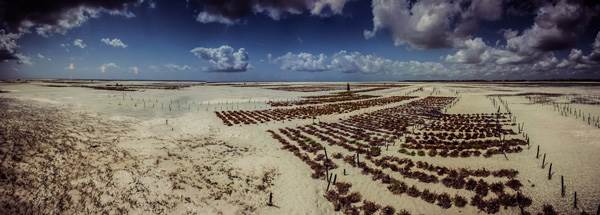
We had arrived 2 days ago on her beautiful, but touristy home-island. Until the 1964 Revolution, Zanzibar was ruled by a sultan, overthrown in favor of an experimental union with the (then) republic of Tanganika. That abruptly ended the Omani influence and the archipelago's heyday. Zanzibar had long been the centre of East Africa's slave, ivory and spice trade, enjoyed economic prosperity and became the birthplace of swahili culture, a unique blend of African and Arab heritage. The largely conservative Muslim society is proudly distinctive from the rest of Tanzania, and Pemba island still dominates the world's clove trade.
This is a foodie paradise. For our first night out, Neyfuu took us to Forodhani (Jamituri) Gardens, for zanzibari pizza (a chapati stuffed with minced meat) and mishkaki (kebabs)

Many tourists mingled abut in skimpy clothing; it was the largest concentration of whites we had seen since leaving SA

For breakfast, Neyfuu and cooked Omani bread (resembles a French crepe) with clove honey from Pemba and ginger tea…

Everything tastes better in Zanzibar. We did don't sample what proper restaurants - you the kind of places your order tilapia and they bring you embellishments of fruit and flower - have to offer. This is all street-side food. Locals start their day with a dose of carbs: usually Zanzibari bread (bolo), Pemba bread (like a double toasted bolo), maandazi (you may see it spelled andazi, and is a small doughnut which in Zanzibar is perfumed with whole cardamom), chapati or another variety (and there are dozens). Bread goes with spiced masala or ginger tea (chai rangi - simple, or chai maziwa - with milk). Sure, if you need to move some tons of charcoal and sugarcane with your bare hands, you might go for a hardier breakfast, like soup.

Top shelf: bolo. This is a typical village breakfast stall, unmarked, camouflaged behind a curtain. Hungry? See a curtain? Pull it, and there's your food, man.

We've got one word for you: Darajani. This is the central market in Stone Town, where all vendors, flavors and temptations collide. We walked through, taking bits of everything. As usual in African rural communities or muslim countries, hospitality is key. Vendors were happy to refill our tea cup over capacity and street-side mamas frying fish to see us returning for seconds. Something caught my eye with this one mama. 'It's tuna', she said. 'Do you eat this?'
We did. Tuna is arguably an unsustainable fish, but it's so good, raw or grilled, but fried? The perfectly crispy on the outside, juicy on the inside chunk of tuna swung a magic broom in our gustative memory, clearing an instant space, where sushi used to be.

Octopus soup

Beef liver in mango sweet and sour marinade

Oversized boflo


But there's more: skewered scallop, squid, mussels; beef soup; potato dumplings… Even chinese noodles rolled by the chinese, drying on outdoor platforms.

To refreshen the palate between bites, there is a mind boggling variety of juices: sugar cane, passion fruit & avocado, tamarind

We pondered the time and effort needed to produce a 200 Tsh (10 Euro cents) glass of perfectly chilled sugarcane juice: the cane needs farming, harvesting and transporting to the juice stall; where a man would work for hours to clean it and cut it, then when the thirsty crowds gather, he will roll the cane through manually operated machine to squeeze the sweet liquid, which is mixed with crushed ice, and we haven't even started about where does that come from. Now, we are not Gargantua and Pantagruel. To make space for more of the good stuff, we took a walk around Stone Town, the pulsating heart of the island.
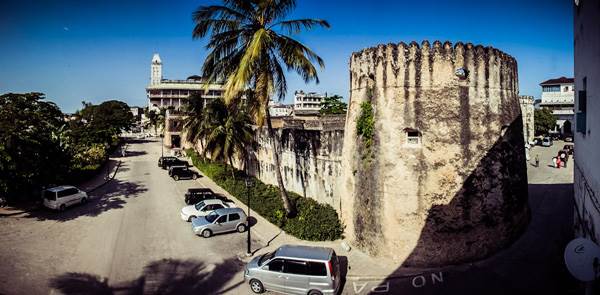
Narrow alleys, double storied houses with diminutive spice & handcraft shops @ ground level and veiled women reminded us of the Moroccan medinas. Ana was toting the empty eco package from some fruit she had bough a few hours ago in a village, which kept instigating touts to ask if we were from the 'spice tour'. It turned out that on these 'spice tours' tourists receive the most ridiculous woven hats that resembled Ana's basket.

Zanzibar has around one million of predominantly Muslim inhabitants. Mosques, madrases and caravanserais blend harmoniously with churches and hindu temples into the townscape, with their simple white facades decorated with suras from the Quran and pavilions so typical of early Arab architecture. Since 2000, the capital of the small archipelago has been a protected UNESCO World Heritage Site.

After looking like a miniature Djema El Fna last night, now Forodhani was quiet and sunny

In the heart of Forodhani lies the jewel of the late Sultan Bargash, the 'Harun ar-Rashid' of the Busaidi family. The monumental building with elements of Victorian and Indian colonial architecture was dubbed the 'House of Wonders', because at the time it was the only house on Zanzibar that had electricity and even an elevator.

Imposing gates, portals and shutters are a characteristic of the old quarter of Stone Town. Decorated with symbols of status and prosperity (lotus, water lilly, the sun), wood inlays and calligraphy (Quran verses), they are indicative of the diverse of Arab, Indian and Swahili heritage, providing information about the owner of the building, his origin and even his trade.



Even the newer doors bear an important significance, and make mandatory wedding gifts for newlyweds


Gujarati style doors at the main entrance of the Ismaili jamatkhana (mosque)

'I'm ready' I said, after a while, 'let's hit the fruit stalls'. Everything seamed to be miraculously in season: passion fruit, star fruit, banana, daf (young coconut), embe (mango), parachici (avocado), pawpaw (papaya), durian, bread fruit and anything you could possibly desire. But we knew what we were looking for, something we have seen before in Asia but had yet to try. The oversized testicle of the fruit world. 'Nataka fenesi', we asked left and right, and soon enough we had found our dealer. He quietly cracked it open. “Check this out,” he almost whispered. Inside, pearly yellow clusters of perfectly ripe jackfruit.

Isn't it awesome to feel like a kid again, and eat something that tastes like banana custard with your hands? Sure, there will be some of that sticky stuff oozing from the center all over yourself, but dang, baby. Jackfruits, they is fine.
Now, it was time to see some island. One option was the inexpensive dalla-dallas, but I had to have an engine between my legs. Nassur called a chap who would give us a Honda for 2/3 of our daily budget. 'Local price', he said. After a moment of self doubt, we shrugged and said: hey, its' okay. We could indulge in great food for under 3 euros for both per day and we would sleep al-fresco anyway. And this bike was light enough for Ana to also have a go. First, we headed to the northernmost point of the island, Nungwi.

Free feet, at last. We kicked off our suffocating shoes, peeled off our stinky riding socks and let a bazzilion molecules of mother earth massage and tickle our soul and our soles.

From Nungwi we rode south along the east coast to Matemwe, where direct weekly flights between Italy and Zanzibar had resulted in a eclectic scene: fishermen greeted us with a 'ciao, come stai?', Italian-speaking Maasai tribesmen (or people wearing a costume, who knows) stand guard by resort entrances, while local men and veiled women mended their nets. Some kids wanted to skanderbeg.

The more south we went, the more touristy it became. As a longtime cyclist quoted in his excellent blog, 'there are certain places, surrounded by a halo of romance, to which the inevitable disillusionment which you must experience on seeing them gives a singular spice'(Somerset Maugham). Hectares of trees had been long wiped out, there is little, if any, wildlife left in the now 'privately owned' Joziani forest and there is a hectic display of real-estate bubble waiting to pop. Unfortunately many contend to enjoy their white beaches and turquoise sea, while whole communities are being disenfranchised and dispersed to make place for more and more buildings. (A note to fellow Romanians: we recently learnt that Vama Veche beaches have became so trendy that some streches have now names!). In Jambiani, we couldn't enjoy our passion fruit snack, without constantly being offered 'cheap' accommodation, collectables and henna tattoos. Riding through coral stone settlements we found peace again.


We had spotted an empty compound where we could camp, but then we found an empty resort near Uroa, where they would allow us to pitch the tent and indulge in decent wifi.

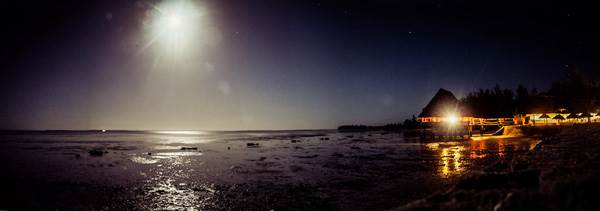
We slept well, the roar of the waves splattering the reef carried ashore by the south east monsoon wind. In the morning, the dhows floated enigmatic on the rising tide.



Halfway between the southern and northern tip of Uguja island, the surf retreats every six hours many kilometers away. Great for beach riding.


At low tide, the wet mass of sand stretches naked. Small pools of water were busy with sea urchins and starfish.



This guy had a psychedelic glow

It is the ideal environment for aquaculture of red algae ( Euchema spinosum and E. cottoni), used in the food & cosmetic industry. Seaweed farming is exceptional, because it is an environmentally responsible trade and because women famers can earn up to three times than what men earn in commercial fishing. In the village of Pongwe, a handful of locals had come out to work. Fatuma was among them, and soon enough she invited Ana to give a hand.

For a while, Ana fantasized about staying in this corner of paradise and work on the plantations for a few months.


Once harvested, the seaweed is sundried. The government has provided women with access to coastal waters, ownership of seaweed plots and negotiated on behalf of farmers a fairer harvest price with export-import companies.


An interesting fact is that algae could be an environmentally friendly source of bio-fuel, one that, unlike alternatives, does not compete for arable land. But transition to a bio-fuel revolution could be far from happening, because of the recent emergence of women as primary bread-winners in the conservative Zanzibari society. And maybe it would be better to stay this way, because venturing into the global market always has its negative perks. Anyway, after spending a few days in Zanzibar, it was time to go. Say good bye to the surreal seaweed fields and the romantic dhows.



Tenga, a woven fishing basket

We left Zanzibar with mixed feelings. We guess it could still be viewed as a relatively unspoiled paradise, but the tourism industry is striving to change that. Ordinary people born on Zanzibar or Pemba hardly reap any benefits and remain largely uneducated and poor, and younger generation is favoring a return to autonomy of the archipelago. But the culture, landscape, food and especially people of Zanzibar made us fall in love with this place, dreaming to ever return, and maybe stay.
|

3 Jul 2012
|
|
Contributing Member
Veteran HUBBer
|
|
Join Date: Nov 2007
Location: Perth, Scotland
Posts: 202
|
|
|
I have to say this is a hell of an adventure, you guys are living the dream, well impressed with the photography and the story, keep it up and stay safe!! Gino.
|

12 Jul 2012
|
|
Registered Users
Veteran HUBBer
|
|
Join Date: Mar 2010
Location: Bucharest, Romania
Posts: 117
|
|
Quote:
Originally Posted by Rondelli

I have to say this is a hell of an adventure, you guys are living the dream, well impressed with the photography and the story, keep it up and stay safe!! Gino.
|
Thanks Gino! We're struggling to finish on a positive side but the last countries in Africa are not easy.
Cheers,
J+A
|

17 Jul 2012
|
|
Registered Users
Veteran HUBBer
|
|
Join Date: Mar 2010
Location: Bucharest, Romania
Posts: 117
|
|
|
Fast Forward!
|

17 Jul 2012
|
|
Registered Users
Veteran HUBBer
|
|
Join Date: Mar 2010
Location: Bucharest, Romania
Posts: 117
|
|
|
Natron Schmatron
Tanzania 08 - 10/06/2012
We had returned to pick up our motorbike to the crumbling old customs in Bagamoyo

Our mood - even if we were returning from the stunning Zanzibar - was crumbling as well. To top the list of gear that has been slowly decaying to bits (tent, mattresses, clothing etc), in Bagamoyo we had new wounds to lick. Our MacBook and 24 mm Canon lens had been damaged, after an unfortunate incident that involved a concrete slab. Camera appears to be ok. We duct taped the lens, but there even hand held it will focus one out of maybe fifteen attempts. A small disaster we have yet to come to terms with, now that vagabonding has tempered with our attachment to material things. But these things were tough to get.
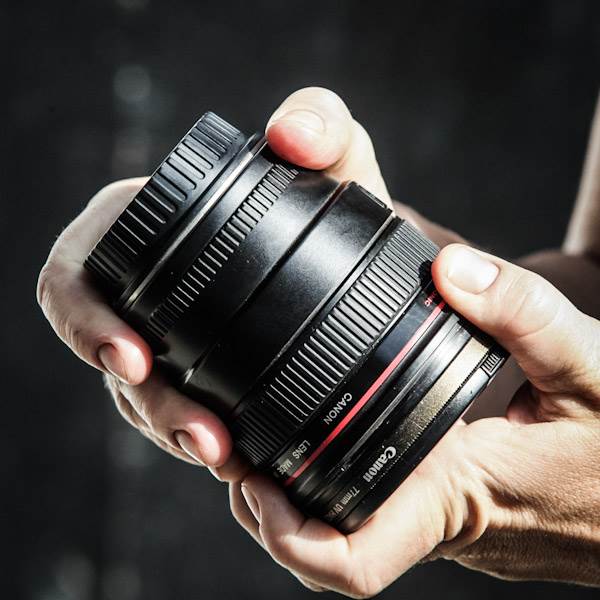

Blogging, documenting and taking photos have been all integral to our journey across Africa. If we are to continue doing so, we must find a replacement laptop and lens. Besides shopping for sponsors (so hard to come by), we never planned that other people somehow fund our travels. We left thinking that we'd find temporary jobs while traveling or scramble. But after 1 year on the road things are getting a bit desperate. We are now looking for the cheapest way to replace these two essential tools.
Maybe you know retailers or dealers who might be interested in offering a hefty discount or even sponsorship to us? Maybe you’ve enjoyed reading this blog and even if you've been saving all year for summer holiday you might still consider contributing, if you can, something towards covering the cost of the broken bits. … If so, please get in touch, any information/support is very, very much appreciated indeed. It is also why for a while there will be less photos in this report and why you can now see the dreaded paypal 'donate' button this link . Hopefully you will not see it for long, but if you decide to click it, your support will not remain unrewarded. We have selected 5 photos representing 5 special moments in our round Africa trip. For any donation of min. 20 Euro, we will post from Bucharest the photo of your choice, printed on B5 format and signed.

Africa never forgives a mistake, but we were still in the game. One of the reasons we went west, on the border of Kenya and Tanzania, was to see a soda lake with water nearly as basic as ammonia, that breeds 2.5 million of endangered Lesser Flamingos: Lake Natron. This salty red hell of algae and cyanobacteria is one of Rift Valley’s most environmentally extreme spots. Natron is close to the more famous Ngorongoro crater, which could provide us with the opportunity to ride along another amazing place. It took us a day and a half to arrive there, actually in Moshi, after sleeping a night in a sisal plantation.

Sisal farming is experiencing a revival in Tanzania, once world's largest grower, now a distant, albeit promising second after Brazil. In the late 19th century, in what was then Tanganyika, seeds were smuggled from the Yucatan peninsula in Mexico. Today over 2 million Tanzanian smallholders are growing sisal, but in the meantime even the economic significance of the plant has changed. Traditionally used to make ropes and twines, the sisal lint is now used to reinforce plastics in car interiors, in roofing materials, piping, and fiberboard. The low grade fibre is even employed in the paper recycling process. Sisal is a promising source for biofuel. Not to mention that the plantations make a nice background for camping.

Road to Arusha

At 5895 m, Kilimanjaro, Africa’s highest mountain and arguably its most iconic landmark was right in front of us. An impressive sight. At least it would have been if it wasn’t completely hidden behind the thick dark cloudscapes. We took some dirt tracks among lush coffee fields, hoping to find a spot where, if we squinted really well, we could see a shadow in the fog. There's your Mt. Kilimanjaro, better luck next time.

This guy confirmed that what we could not see was indeed the famous mountain
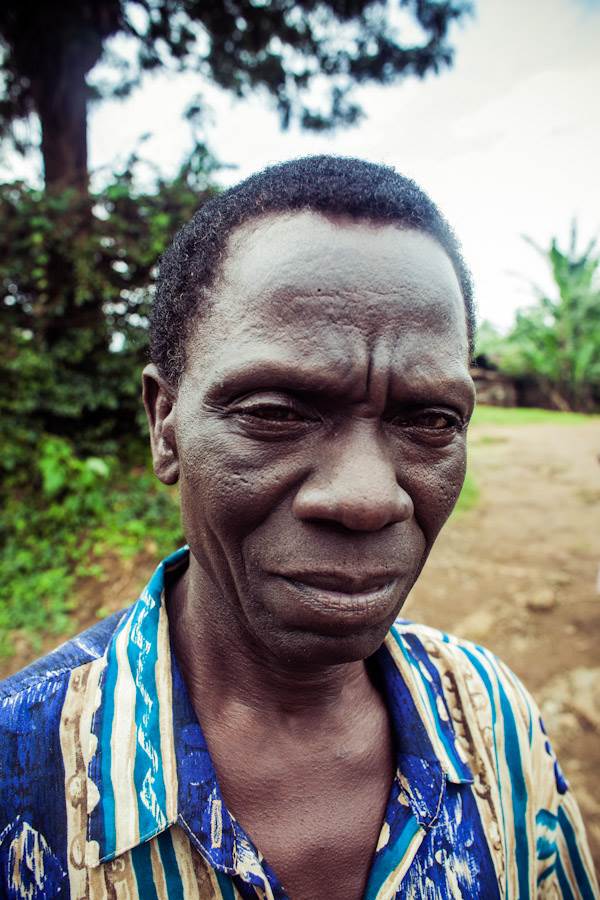
Mount Meru was a bit more visible.

And later these long extinct volcanos were a nice backdrop for our freedom

To reach Natron, you need join the good tar leading into the crater. These few miles of 5 star road are populated by innumerable safari jeeps, that stop here and there, so that the tourists can step out and snap Maasai tribesmen and women. If until recent times the nomadic people of Tanzania and Kenya have been discouraged to modernize their way of life, things are now changing. On the way to Ngorongoro one can see dozens if not hundreds of Maasai (or are they?) lining the road, masquerading the traditional attire, waiting or even begging to be photographed for money.

Then we turned right. There's always something therapeutic about leaving the long straight lines of tarmac and zig zagging among mountains and valleys, helmet flooded in sweat, until you and your bike can finally breathe again.


It was scalding hot, kooky cacti forests sprayed across the vast expanse of mattress-puncturing acacia where few Maasai compounds scattered. These are called Boma, and are inhabited by man and domestic cattle alike. A hut takes 3 days to build: a timber framework is fixed directly into the ground, then a web of branches is interwoven with it, and finally plastered with a mix of mud, sticks, grass, cow dung and urine, and ash. The traditional Massai society is patriarchal and polygamist, centered around cattle, the primary source of food.

The occasional Maasai stared vacantly at us as we stopped to contemplate asking permission to take a photo. They were wrapped up in Shúkàs (traditional red and purple plaid blankets) and wore bike tyre flip flops. The Maasai believe that a camera can steal their soul, but since mass tourism has conquered this land, things changed. We already are too shy to shove the amera in someone's face, most times we prefer to spend some time with the people, interact, introduce ourselves etc. Now there was also the photo-for-money paradigm to negotiate. Nuyara gave us a minute.

The site of world's largest volcanic caldera stirred our souls. Somewhere beyond it we could guess the Great Open Place of Africa, Serengeti.

We stopped at the edge of this horizonless, dramatic natural arena and gaze not at one, not two, but at three volcanos

We had researched our destination: some travelers had reported Natron to be infested with hasslers, blocked by illegal toll gates. People had been forced to pay hundreds of dollars at gunpoint, escorted from their bushcamp etc. We hoped those reports had been accidental. In Arusha we confirmed with the police and several travel agents that Natron is not a national park, that there should be no fees (except for a 1 Euro community fee in the village), no problems. Then, we arrived at a barrier. Someone had painted '15 USD' at the bottom of a wood board, obviously after it'd been mounted. That was the first 'toll gate', so the reports were accurate. We argued in vain, and soon the first dude with AK47 showed up. They told us that there was a second 'toll gate', where we should pay 10 USD. So 50 dollars to see the lake. As we were turning back, a bus crammed with locals arrived in front of the barrier, and suddenly a white arm sprung out waving and someone shouted 'great country!'. Almost instantly the barrier was lowered and more vigilantes and AK47 appeared. The unfortunate man who couldn't contain his enthusiasm and had to salute us, proved to be a tourist accompanied by a Tanzanian lady. He had a letter from some NGO, that should exempt him from paying the 'fees'. If he had kept his mouth shut, the bus would have passed through. Everybody started to shout and argue, and it became clear that we will not be allowed thru. It was time to concede that Natron was not meant to happen this time.
Retracing our tracks back to the main road, we still felt good, tripping on hot baked-in chemicals, released off the ground. Nothing in the tranquil and warm landscape that sheltered our last night in Tanzania let us suspect that we were about to pay for all the good times we had had.
|

23 Jul 2012
|
|
Registered Users
Veteran HUBBer
|
|
Join Date: Mar 2010
Location: Bucharest, Romania
Posts: 117
|
|
|
Rogue Weather In Kenya
Kenya 10 - 27/06/2012

Thank you officers, for letting us in. The 20th African border penetrated by a vehicle carrying no Carnet and the first Romanians around Africa. Get all the details on how to skip CpD here. 50 bucks paid for 30 days of man and 20 for 30 days of bike. 'You're not afraid of wild animals?' said the customs officer. 'No, dude, I'm the Romanian Mowgli' I said to myself. But there was no time for that, sun was about to set in 40 minutes and we were in the proximity of Tsavo National park, roamed by elephants and lions. We claimed the first flat empty spot, and dang, we had a bedroom. Four Kenyan ladies stopped to giggle at the strange squatters. Pauline had curly extensions and cute dimples, Ruth didn't speak much English, Janet couldn't stop laughing and Beatrice was sporting a pink shirt and a cracking smile. 'Do you want to come to my house?' she offered. We looked at each other - you know, staying with locals is what we love best in this adventure. But we were too tired to be the village superstars that night. Our camp was already set on the best surface possible. And it would be pitch dark within minutes. 'Is it far', asked Ana. 'It's just there', the girls pointed to the nearby shrubbery. 'And you could wash your body'. Now, how could we refuse that? We packed, and off we went: Ana on foot with the chatty gang, me on the motorbike. For the 2,5 km to Beatrice's compound the giggling didn't stop. To the surprised villagers we kept being introduced as 'visitors'. Look what a lovely spot we had in Timbila village, on the river Lumi. Our hosts told us that elephants and even lions come often close to the compound, but hakuna matata, they will use pots and pans to make the big noise and scare the beast away.

28 years old Beatrice is from Mombasa. Her traditional name is Mwanaidi. She is a busy housewife, but also a trader, buying hoho (bell peppers) from farmers and selling them on the market. She has 2 daughters: Eunice (8) and Faith (3). Now she is on birth control, as are her best friends. Beatrice cooked the kenyan staple kitere (also spelled ghitere), which is maize and beans. After dinner she fetched us a bucket of water for shower. We lingered a while longer watching 'Kenya's Got Talent'. It felt awesome to be there. As the night before we had mentioned that we liked chapati, in the morning Beatrice organized a chapati workshop for breakfast.

Bea's husband, Gadiel was born on a bed of banana leaves, which inspired his mother to also name him Madundu (which means banana leaves). He turned out to be the village chief deputy, so he insisted on taking a photo in his official uniform.

Imagine we had to deal with dozens of people like him in Zaire, Cameroon, Nigeria. Uniforms, guns, spiked barriers inspire fear, but many of these people must have been like Gadiel, honest, God fearing, simple family men. In this chiefdom (Taveta), as in many other parts of Kenya (and Africa as well), the deputies struggle with staggering HIV levels, poor school attendance and ever dwindling buffer zone between wildlife and human settlements. Also many villagers tend to favor the traditional marriage (to avoid dowry) which allows several sex partners, making birth and AIDS control almost impossible.

In their compound, our kenyan friends have electricity, TV, laptop, even a dongle to connect to the internet. We downloaded the pics to their PC, also printed out a couple. After more chai maziwa (spiced tea with milk) we regretfully said our good byes and got back in the saddle. We needed to be in Nairobi asap, to sort out the dreaded Ethiopia visa.

Not long ago, we had spent days riding similar roads in Mozambique. Deep red dust covered the narrow stretch of land cut across an impossibly green forest.

Soon enough we left the last huts behind. Game was the only thing that could slow our pace down, but it remained elusive.

Only when we hit tarmac we spotted the first wildlife: zebras grazing in the debris of human consumerism.

Tsavo National Park is transited by Kenya's busiest road: Mombasa Highway. One constant stream of trucks, transporting goods from the coast to half a dozen countries. There was only one option to both drive and live, so we stayed on it for only 50 km. An abandoned building caught our attention, so we stopped to explore a bit.
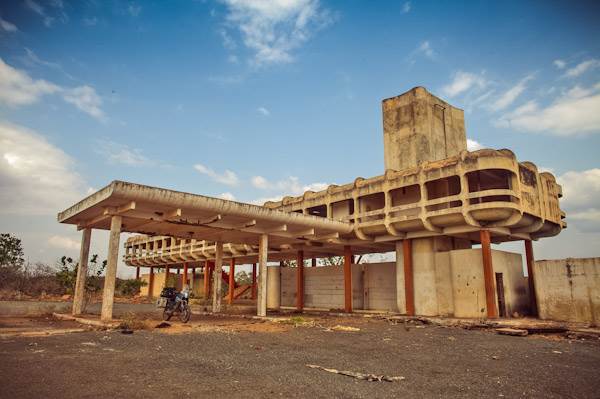
The concrete structure well executed, solid details, interesting spatial design - this once busy restaurant must have been a welcome stop for travelers in the middle of nowhere. Probably in the heydays of this place wildlife was still around.




As we climbed the last plateau before the escarpments of the Rift Valley, to the 1660 m altitude where Nairobi is situated, air begun to cool off. In the astonishingly modern capital of Kenya and economic centre of East Africa we hit the afternoon traffic jam. In a way we had a deja vu, remembering Lagos, but this was a clean, disciplined, far less congested version of the Nigerian metropolis. The Maasai name for the city was Enkare Nairobi, which means 'cold water'. Once nothing more than a swamp, Nairobi became a necessary base camp for the british engineers and their african and indian workers, who were busy building the railway. Even if the Equator is a few hundreds of kays away, the weather is never pleasant. We arrived with winter, so it was very cold, averaging 14-15 degrees. But Nairobi winters are dry. If only we should be that lucky… With the climate changing all over the world, rains have become less predictable, so we had them falling almost on a daily basis. Believe us, camping on wet mud and grass and shivering in the tent is not fun. Our pep: this cute chameleon we nicknamed Pinocchio

If in over one year we had barely met 7 teams of travelers, of which all but two were already home, in Nairobi we suddenly were in over-lander's world. The compound we were staying in was choking with cars, trucks and bikes, the shared spaces busy with backpackers and even a Japanese nomad musician. Yusuke backpacked all the way to Kenya, where he decided to buy a bicycle. His songs about what he had encountered on the road provided us with fresh inspiration for our own quest.

One of his songs about Mongolia pretty much describes how we feel:
'Walk/ Walk everywhere/ Until the air/ Is New
And you reach the other side'
Listen to Yusuke (Charu) singing
We had to deal with the bike



The gear lever I had manufactured in Mozambique from a chinese scooter was still in great shape

And sort our Ethiopia and Sudan visas. Thanks to the Sudanese embassy that requested a letter from our own embassy, we met the wonderfully gracious and friendly people who work at the Romanian mission.

We couldn't thank enough for all the support, good advice, care and awesome food. Check out the Romanian braai.


The visas proved to be less tricky that expected. We had an interview with the Ethiopian consul who was persuaded by our Congo extravaganza; a few days later we had the stickers in our passports. As always, you win some, you lose some, so while driving in the city we had our first flat tyre in over 50,000 km!

Geoffrey, a biker who has been following our story on advrider, invited us for a Kenyan feast. A good meal means here 'nyama choma', which is swahili for 'meat on the fire'.

Look what this guy was chopping for our party of seven:

Let's say that it was not all meat: there was some fried banana and cabbage involved as well

Our eclectic gang (us, Geoffrey, Jack, Andrew, Kaizer and Joe) debated everything from arts to politics. Kenya is rapidly growing into a powerhouse that bears less and less resemblance to its less developed African neighbors.

Jack Rooster is an emerging Afro-beat DJ. Listen to his stuff here
Joe Barasa is a self-taught illustrator, currently working for Shujaaz.FM, a monthly comic book written in sheng (the contemporary slang language of Kenyan youth). Shujaaz means 'heroes' in Kiswahili. It is a series of stories shared on different media platforms: a 32 page comic book published online and printed monthly in the Saturday Nation newspaper, Kenya's biggest publication; also broadcasted via daily FM radio programmes on more than 17 FM radio stations around Kenya. The agenda of this pioneering magazine is to feed the young generation with information and empowering ideas, to motivate them to become proactive and responsible within their communities.

We had to leave Nairobi, come rain come shine. It had rained all day and all night before our departure, we were chilled to the bone, tent, mattresses, sleeping bag all wet or damp, so we had to dry them a bit before setting off. We didn't go too far though because of a second flat tyre.

Minutes after I managed to solve that, rain started again. Soon it was pouring cold waters, and we were driving on the famous stretch that should offer 360 vistas over the Rift Valley. We couldn't see squat, so why stop in the downpour to try to take photos of grey fog and whatever else was there with a broken camera that doesn't focus properly? We hold on to our horses and endured the torture. In Naivasha the rain had become a more merciful drizzle, so we stopped in front of a shack for hot tea and andazi. I think that tea must have saved us from a serious case of hypothermia. We pitched on the shores of the lake, where all night we could hear the hippos grunting and grass-munching, their chunky bodies barely visible from the swampy field.



This was no Congo, so riding for days with cold water in our boots was out of the question. We decided to cut our visit even shorter, and because there was a bit of sunshine, stopped to see the flamingo colony that inhabits lake Naivasha



You'd be wrong to believe this is some kind of pristine wildlife heaven. Lake Naivasha, one of the few fresh water lakes in the Rift Valley, is an environmental disaster. A huge flower farming operation has long been established around the lake, pumping waters and spilling all sort of hazardous chemicals back into the habitat of endangered birds. Some years the water levels in Naivasha have been so low that one could walk for 150 meters from the shore. The flamingo colony is a shadow of its former past. Unfortunately the flower industry is flourishing, and when it'll be finished with Naivasha, it'll find another lake to deplete. It's a strange thing to think about when buying roses in Europe, isn't it?

The area around Naivasha is still home to a fairly healthy population of antelopes, warthogs and zebras. We spent the rest of the day - that was mostly dry - crossing several times the Equator


Lake Elementeita, another soda lake of the Rift, and another desolate sight, once home to a vast colony of flamingos

A last nyama choma, with a side of kenyegi (mashed potatoes with spinach and corn)

As we reached Mt. Kenya, the weather turned rogue once again


There was no way we could stop in Nanyuki, as planned. We pushed thru the night, to escape the highlands and the rain, until we arrived in a village where people had congregated to watch a kung fu movie in the only tea'n doughnut joint. Miraculously, by the river we found an unfinished lodge where the owner allowed us to camp for free. There were no facilities, the toilets were appalling, but the people were extremely friendly, putting up toilet paper for us in the loos. And because the place was still under construction, we were alone under a clear sky.

With no rain after two weeks of it, smiles started rolling, happiness unjammed and we were feeling A-OK. Who cared we were heading towards East Africa's worst road? For the moment we were rolling on chinese tarmac, filling up on cheap tea and more doughnuts, enjoying the treat that lasted even 140 km after Isiolo.


While a bunch of vultures enjoyed their lunch we stopped to snack as well. Mongooses were creeping up from everywhere.



Probably killed by a speeding car, the anteater had been professionally butchered in search of the best bits



As we entered the land of the colorful Samburu people, the asphalt ended, and the rattling begun. This has been described as the overlander's nightmare and for travelers who do only the East route it must be so. Corrugations are profuse and so dense that even at low speed you can feel every bit in you motorbike suffer.
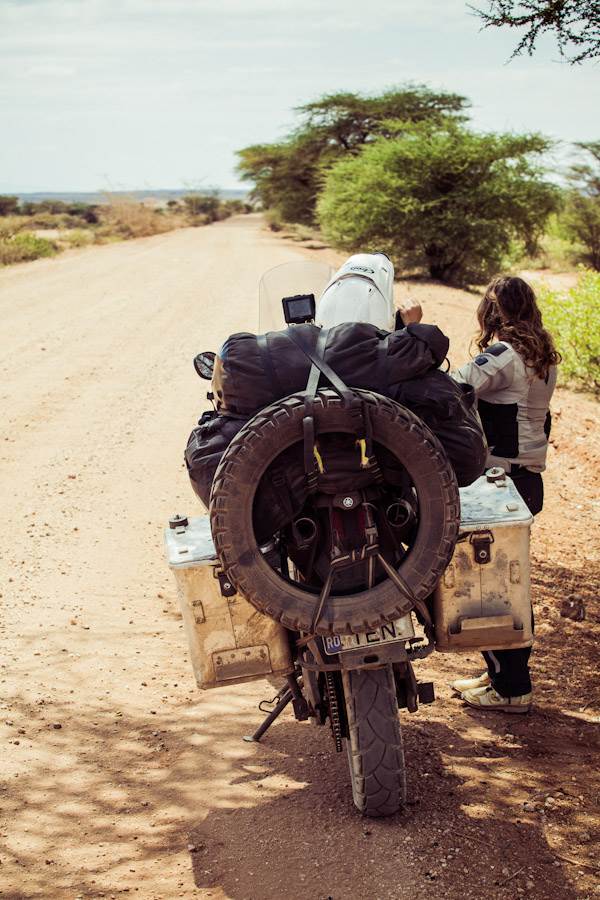
The scenery is superb: mountains creep beyond the veld that progressively becomes a horizonless desert. A handful of mud and dung huts of the nomads who inhabit this hostile environment. Many people came running, asking for water or money. We barely had half a liter left to sheer between us two, so there was not enough to spare. We felt terribly guilty, but we absolutely had to arrive in Marsabit that afternoon, as we planned to continue west, across the Chalbi desert, to Maykona. Once in Marsabit we stopped briefly for tea and the usual doughnuts. But as soon as we left town, the road deteriorated so much, that we started to question the entire plan.


|

23 Jul 2012
|
|
Registered Users
Veteran HUBBer
|
|
Join Date: Mar 2010
Location: Bucharest, Romania
Posts: 117
|
|
We remembered the dramatic report of tsiklonaut from the Turkana route and this was starting to look more and more like what he described. The best stretches were relatively hard, but so corrugated that we could feel our bodies splintering to molecules. The rest of the road was an unpredictable carousel of loose gravel and rocks. Sometimes we would find ourselves suddenly riding on soft sand, then on our absolute favorite, something that could be best described as a swamp of boulders. A hot dry wind kept blowing across the veld that barely allowed a shadow.



30 km and we were spent. With our current speed we we unlikely to arrive in Maykona before night, we were going to visit to somebody there. But that meant that to go to Ethiopia, we would have to do this 75 km of pure hell again, on top before the Marsabit to Moyale ride. Was is all worth it?


Once our brain cells cooled down a bit; we could think more clearly
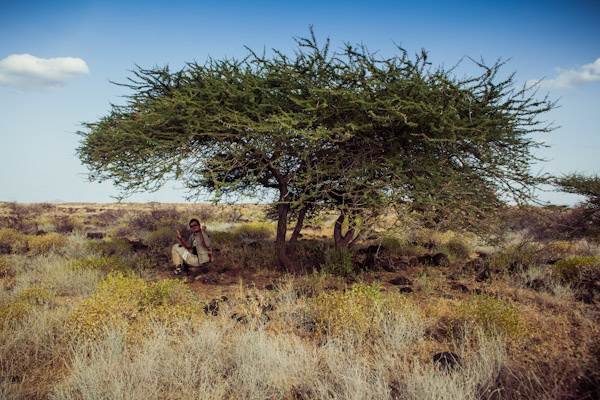
So the night found us back in Marsabit, camping in the compound of the Catholic Technical Highschool, and dining on kenyagi with our generous host, father Francisc. After watching together venezuelan telenovelas, we said good night, only to reunite for tea in the early hours of the next day.

The Marsabit to Moyale failed to live up to the terror. It went down like that:


Of course we didn't stop to take pics on the worst parts, which were quite similar to the Chalbi road. Loose rocks or a deep layer of gravel mixed with sand, but the really rough parts only last for about 50 km. The Chinese - almost ousted from this project - are back working on the road as we are writing this. Some stretches have been leveled and you want to take all the deviations to spare your vehicle and yourself a lot of trouble. Of course that you have to be on the ball, looking out for those moats and potholes, careful to spot a shadow for a ditch.
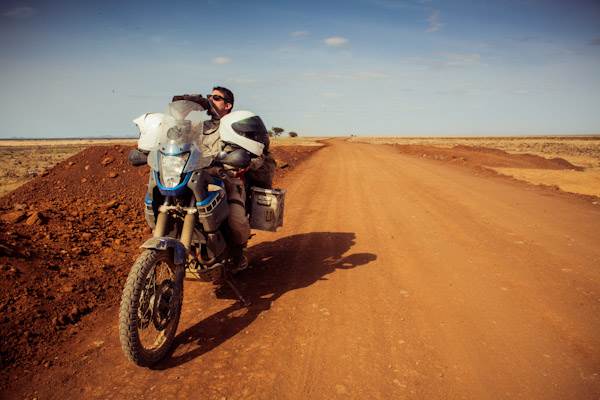
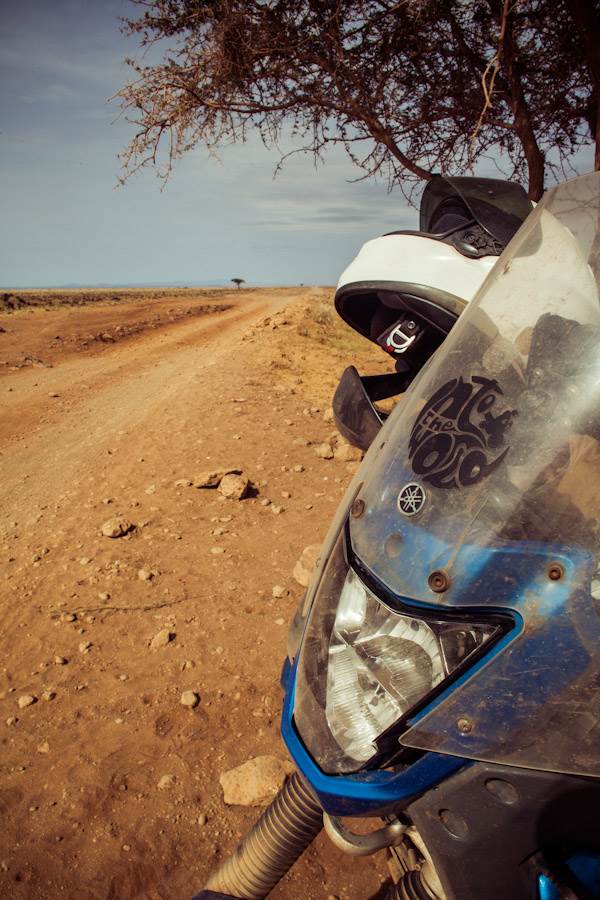


We encountered vast herds of camels and sheep and many Borana nomads


At a very reasonable 2 p.m. we were in the congested little town of Moyale. Now my bike now had been there, rode that and lived to tell the tale. As we had stopped many times to drink water, and once to snack, we estimate to have crossed the 250 km in 6,5 hours. Of course it isn't as relaxing as it looks, but it is definitely not as bad as they say.

But if after suffering cold rains and a baking desert we had been arrogant enough to believe the hard part was over, soon we would regret it. We were heading to the highlands of Ethiopia, where the wet season was just peaking.
|

29 Jul 2012
|
|
Registered Users
Veteran HUBBer
|
|
Join Date: Mar 2010
Location: Bucharest, Romania
Posts: 117
|
|
|
Planet Ethiopia
Ethiopia 28/06 - 06/07/2012

There’s a marvelous feeling to enter a fresh territory where, like Yusuke sings, the air is new. There's a sense of excitement and the natural fear of the unknown. Crossing borders in Africa is also generally not easy. Custom forms and TIP need filling, passports need checking, money changers need bargaining. In time, we learnt to expect nothing and be prepared for anything. So when one of these uncharted territories proves easy and we get the wave through in a place so notoriously difficult as the Ethiopian border, we know we had a good day. Amazingly enough, the temporary import permit was free of charge, details soon to be updated on our HUBB thread dedicated to overloading in Africa without a CpD. Visa was 20 dollars for 30 days and petrol around 20 Birr/l.
Ethiopia is a very special place indeed, utterly distinct from any other country in Africa. People look indeed different.



Human history here dates back at least 4.4 million years. It is the only never colonized African nation, with its own unique calendar, language (that belongs to the semitic family), alphabet and religion. Sadly, Ethiopia has a very bad reputation among over-landers. But even if we drive the same routes, we don't all often groove to the same beats. Instead of throwing rocks and sticks at us, people welcomed us with shy smiles, confused about the unheard country we were coming from. First night we slept in the compound of a catholic mission:

The next day we hit the 60,000 km mark. That meant 48,000 in Africa! We were climbing the dramatic plateau that boasts altitudes between 1800 and over 4500 m. After a short couple of days basking in the heat of Chalbi, we would soon have to wear the entire content of our backpack under the riding gear. Vernacular architecture proved to be equally original: long eucalyptus poles are used to built a high ceiling single room house, that is often left un-plastered. Some facades are painted in bright colors. In more remote villages huts have kept the traditional round shape, that in the more emancipated communities is only used for storage or cattle.


Even if we are well a decade over the new millennium, most of Ethiopians are still pastoralists. It nukes you back into a rural, mystical age, as if you've stepped into a living time travel machine. Every child is supposed to take part in herding the family livestock, thus the origin of rock and stick throwing. Unfortunately after being saved from the 70s famine by a concerted international effort, the younger generations have lost some of the authenticity and pride of their elders and, accustomed to foreign aid, are more prone to begging and hassling tourists. The markets on the other hand, have pretty much stayed the same, with villagers congregating from many miles away to trade cattle and produce.

Ana told me about a pack of cards she had as a child, the kind that you have to match pairs of two alike to win. Her cards had a ethnic wear theme, and she had now flashes of something quite similar to the Ethiopian getup. The main ingredient being a thick cotton scarf that can become shawl, poncho, skirt, dress, baby sling.



That goes for the plains, because the highlanders favor colorful plaid blankets and mandatory green or kaki shorts for men.

Wandalal (43)

At 11, Ylumaga is a fine herder

After buying some fruit, we wanted to offer a couple of photos to people. Within minutes we had become a mobile free print shop.


Sadly the printer battery lasted only for a short while, and as people were expressing their eagerness to be photographed, a strange vigilante crashed the party. This guy wore no uniform, but appear to command some sort of authority over the crowds. He grabbed a boy's stick and started hitting people away, while shouting at them to disperse. We tried to explain that we were not being assaulted and that his actions were completely unwarranted. As the situation regain calm, we shook some hands and took off. That evening I switched to a second hand Heidenau that Chris at JJ's Nairobi had given us for free.
Since entering the country, we had been introducing our taste buds to new flavors. The staple food is an entirely original Ethiopian creation, based on a cereal (tef) that, much like many of the plants and wildlife that live on this land, are endemic to the country. The tef flour is used to make a watery dough that is fermented, then baked on a clay oven or in an ironcast pot. The spongy and slightly sour pancake resulted is called injera, and substitutes both serving dish and eating utensils.

Eaten with your hands, injera is savored with a wot (sauce) spiced with berbere (a mix of cumin, cardamom, clove, cayenne pepper, ginger and turmeric). With sauteed vegetables, boiled meat or even raw meat. Our favorite was shekel teps, roasted mutton or goat served sizzling hot with peppers and onion

Vernacular Ethiopian being alive and well, injera is not carried around in Tupperware, but in a dedicated basket, woven, then insulated with hide.

Of course the famous Ethiopian coffee is constantly brewed and savored across the nation, with much ceremony. The beans are roasted on the spot, incense is being burnt and the smooth velvety liquid sweetened.


Not being huge coffee drinkers, we favored the ubiquitous 1 Birr tea. Beer is available either bottled or locally brewed from germinated cereals in the countryside, where your drink it from tin cans.

Nothing was as good as the insanely delicious fruit juices, like this mango/ avocado/ papaya creation
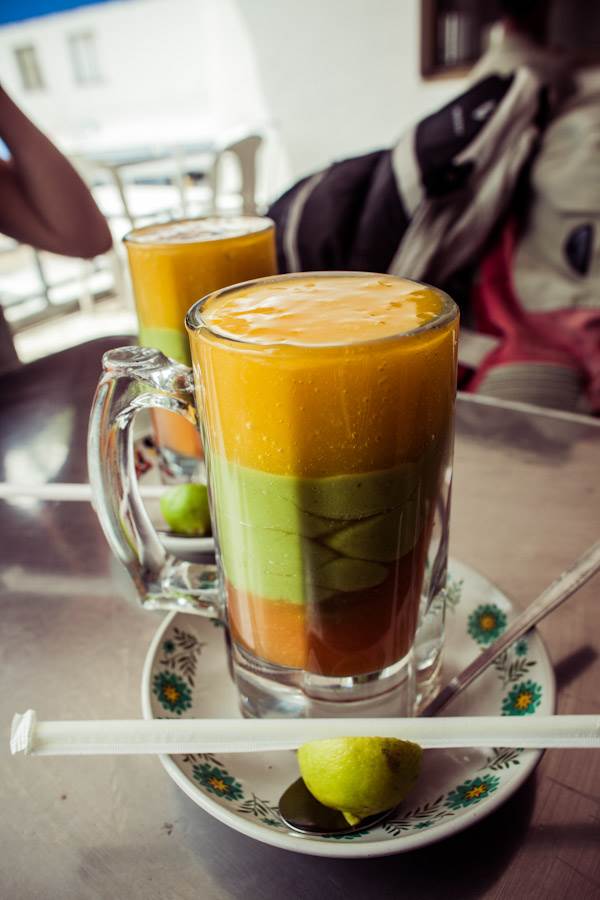
Making our way north, we passed Lake Abiata national park. As they wanted us to pay a bribe to ride to the shores, we entered a mile farther, on a dirt track. Unfortunately, there was not much to see: a few flamingos scattered, and some donkey.

At the shores of Lake Ziway the barrier and ticket office were just being sorted. Local fishermen can still picnic next to pelicans and some tall storks. Hopefully when they'll start collecting money for this place, it will go into some environmental damage control.

Being so different comes with a few quirks. Ethiopia also claims to have the undisputed diplomatic capital of the world dominated by an 'italian' piaza, to foster the Ark of Covenant, to be the center of orthodoxy. Ethi-utopia anyone? Addis Ababa, with its hectic urbanism, with immense governmental compounds lost among scruffy boulevards, had little to support such preposterous claims. To us, the soviet influences were too evident to ignore, and the modern developments too kitschy and amateurish to bare. Hosted with unparalleled hospitality by our Bulgarian brothers, we were for the first time alone, an entire apartment to our disposal. Not having to squat in a disintegrating tent under the daily rains was bloody fantastic, also offering Ana the required peace and comfort to experience her first food poisoning in a decade of backpacking and hardcore street food sampling. In between downpours, our friend took us out for coffee and some sightseeing.

After visiting the imperial paraphernalia in the nearby museum, the Raguel church (with a circular layout, built by an indian artizan) felt equally bland

The modest palace of Menelik, situated on top of Entoto hills was quite interesting, with superb roofing details

After taking a few days off because of Ana's injera overdose and having to deal with ridiculous foreign currency laws in order to buy some much needed cash for Sudan, we realized the Wadi Halfa ferry would leave in a few days. We had to decide: a sprint to the border, or hand around for another week and catch the next one. This infamous boat is the only border crossing into Egypt, and leaves only on Wednesdays, if it runs at all. For us, that would be the second time we would rush like that, after the adventurous crossing of the Congo. The first step, crucial to the success of our endeavor, was to do the Addis - Lalibela stretch in one day. Remember we spoke of penitence for all the good fun had in Africa? Our metal Ark and our sinful beings were treated with Flood. The morning of our departure it started pouring again, cats and dogs. Drenched and chilled to the bone, almost unable to grip the clutch, we had to stop in the first sizable town for hot tea.



Our gear is not designed for cold weather, nor for wet. When it rains, it rains right through it, even with the weatherproof layer on, so it doesn't take long to have everything, down to unmentionables, completely wet. In moderately warm weather a tender wind will soak our clothing reasonably fast, which is great, so far we couldn't complain at all about that. Even in DRC, where we were riding for days under pouring rains, it was bearable. This time, we were shivering at below 14 degrees. The real feel while riding was much lower. It rained almost all day, with brief intervals of modest sunshine which we cheered with disproportionate euphoria, probably due to our advanced state of hypothermia. But the highlands were stunning.





Our gear is not designed for cold weather, nor for wet. When it rains, it rains right through it, even with the weatherproof layer on, so it doesn't take long to have everything, down to unmentionables, completely wet. In moderately warm weather a tender wind will soak our clothing reasonably fast, which is great, so far we couldn't complain at all about that. Even in DRC, where we were riding for days under pouring rains, it was bearable. This time, we were shivering at below 14 degrees. The real feel while riding was much lower. It rained almost all day, with brief intervals of modest sunshine which we cheered with disproportionate euphoria, probably due to our advanced state of hypothermia. 60 km before Lalibela, in pitch darkness, the tar ended and we continued, blind and tortured, on a winding, slippery river of mud and gravel. I'm assuming the scenery was fabulous, I we could see it. That would have made the ride reasonably fun. Over an hour and a half of hell we eventually arrived where we were almost not hoping to reach. We hardly slept, unable to heat our limbs back to normality, but nevertheless, the morning was dry, so we were ready to be dazzled.
|

29 Jul 2012
|
|
Registered Users
Veteran HUBBer
|
|
Join Date: Mar 2010
Location: Bucharest, Romania
Posts: 117
|
|
|
Lalibela - Assume Bedazzled Position
With the impressive 4190 m Mt.Yosef in the background, Lalibela may not feel like it's situated at 2630 m altitude. 8 centuries after king Lalibela of Zagwe dynasty dreamt to build here a new Jerusalem, this remote Ethiopian town is finally fulfilling its destiny. 11 rock-hewn churches, narrow passageways and crypts were carved into the iron-rich volcanic rock. Today not only arduous pilgrims and monks flock to this UNESCO World Heritage site, but also tourists from all over the world.

The soft basalt hardens after carving, but Ethiopian rains are merciless, so, in time, some of the churches deteriorated so severely, that UNESCO has temporarily installed protective roofs. Some of these roofs are quite unfortunate looking, given the context, some give character.


One cannot simply come and see Lalibela. This special place makes you work, like Cambodia's Angkor, on a more modest scale, of course. Climb, walk, sweat, lose balance, get stuck, become blind, be dazzled. Smell the rock, smell the mountain, admire the craft and dedication, written in a stone kept alive with faith by present-day worshipers and students. It's interesting how the layout reads from early christianity, the clothing has semitic flair, and the chanting of verses makes you feel in a mosque.




If the play of shape and proportion is quite spectacular, the interior of the churches left us unimpressed, as did the decorations. Lots of incense and beeswax candles reminded us of the gloomy hopelessness from the Romanian churches. The chanting reverberating from hidden praying chambers were, on the contrary, mesmerizing.
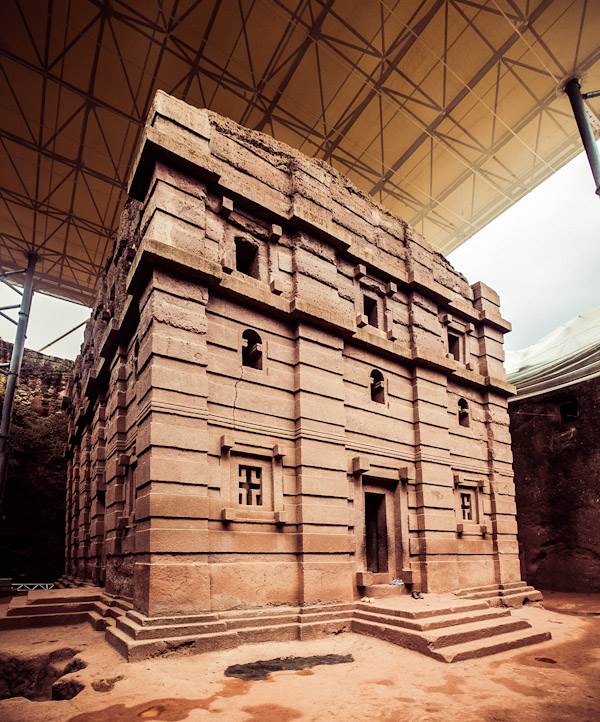
.
Bet Giogios is particularly stunning, emerging, symmetrical and monumental, from the gut of the mountain. The lichens on the outside walls make it even more beautiful and more alive.

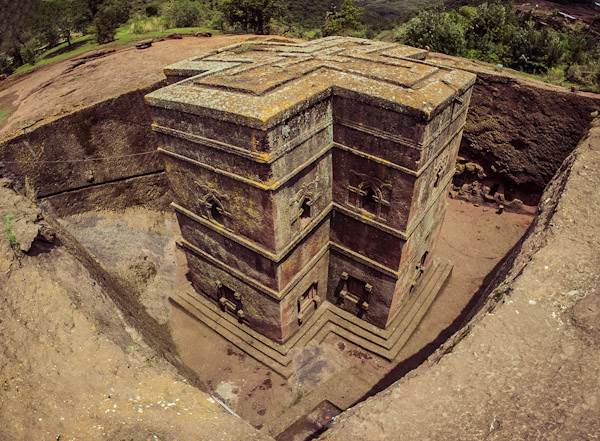
Next to the labyrinth of churches, a rather secular one: the traditional tukul village. Because of torrential rains last for many months per year in this region, contemporary homes have similar design. One or two floors, on top of a round, rock foundation. A real life smurf village.

At the end of the pious circuit, this devilish kid

And his best friend, the guard's son, with berbere smeared around his mouth

Ready to give the descent a go we were, but unfortunately for us, so was the rain. Sky was black with cloud, only lit by even scarier lightning. Ana looked at me. 'I wonder if this is a good idea' she said. I could tell she was worried. And to be fairly honest, my own confidence we could make it to Wadi Halfa under such weather was weakening. I was ready to rock, packing up gear and squinting at Ana when she mentioned the rain, making an 'are you serious?' face. 'Why haven't we looked for ponchos?' she asked. When I replied that we didn’t need any ponchos — the rain couldn't last forever — she said: 'we should have prayed in all those churches'.

It started like a drizzle. We were not fooled, the whole valley was shaking with thunder. Soon the skies broke, and water started pouring furiously. Before I had been mindful of declivities and tight bends, now all I could barely feel was that the road was disintegrating into mush. I would see that soggy bog and hope it was solid, but my front wheel would sink into it, knobblies covered, mud bubbles rising. It was like riding on soap and smutted worms. With the bike sliding and drifting, we just hung in there. Pounded by cascading rain, teeth clenched, fingers and toes frozen, head spinning, the lot. It was not pretty. I don't know if the plastic bags covering Ana's hands can be easily spotted in this pic. I used the same metaljockey trick to cope with the wind.

I don't know how we made it to the junction with tar. If not shivering uncontrollably with cold we would have stepped off the bike to kiss the asphalt. It took another hour to buy petrol from the local mafia (actually from a bajaj driver I decided to stop), as the gas stations were out and the next ones were at 100 and 140 kays in both directions. I should probably mention that, as soon as we took off, it was raining again. For those of you who keep track at home, that is another full week in the wet. In one hour it was dark, and we stopped again. We had spotted a dim light coming from what looked like a tea room. Amira had not only sweet, hot, live preserving tea, but also two freshly baked loafs of bread, with aromatic black sesame seeds in the crumble. Back in the saddle, it took a mere 5 minutes to lose all heat, contort and hope.'Look, a hotel'. Ana shook my shoulder. Only later it would come out that she had coped with the insane weather imagining a chain hotel, nothing more fancy than an Ibis for instance. She fantasized about standard cleanliness, white linens, hot water, a good mattress. Well, our visit to the mystical town of Lalibela would pay off: the ghostly building was indeed a hotel, looking like Ana's fantasy, clean, but dirt cheap. Before we could settle in, windows were screaming with wind and torrents, sky was lit with dramatic lightning. It was scary to think we could have been outside, riding. We devastated the room, using all towels, slippers, blankets and hot water, until our sorry-asses failed asleep like dead people, on the best beds we had seen in 400 days.

The next day was sublime. Impenetrable fortress of escarpments, pinnacles and protruding ridges. Streams and waterfalls gushing through gorges. The mighty Ethiopian highlands. The Abyssinian abyss. We had arrived in the ethereal kingdom of sky, and it had taken our breath away. After leaving our nighttime oasis we were still going up the mountain, sometimes passing the 3000 m altitude, wondering if we would ever reach the plains again. Behind us, the dreadful storm from last night was regaining composure, preparing to hit hard.

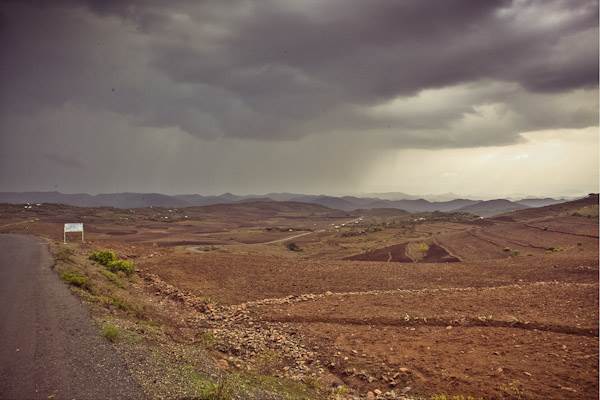
Everytime we would stop to get the green terraces of tef in focus, the sky seamed to darken in anger. We could smell the rain, run, Forrest, run! Only when we were off the plateau and into the valley, seemingly out of danger, rain caught up. A blond sky hovering over our heads let out a gentle drizzle, or at least that's what it felt like, after the pounding of past days. But soon rain let up as abruptly as if a giant tap had been snapped shut overhead. We kept rolling under a changeable sky that was quickly loosing cloud and accumulating heat.

A couple of dozen kays before the border we had to stop and strip. Temperature had been climbing like crazy, from less than 14 to 32 in one hour. Time to eat whatever we had left (banana and bread) and sort our papers out. While waiting for the customs officers to finish their lunch break a wannabe fixer told us: 'you didn't like rain?' 'Now go to fire'.
|

29 Jul 2012
|
|
Registered Users
Veteran HUBBer
|
|
Join Date: Mar 2010
Location: Bucharest, Romania
Posts: 117
|
|
|
Desertaholics
Sudan 06 - 11/07/2012
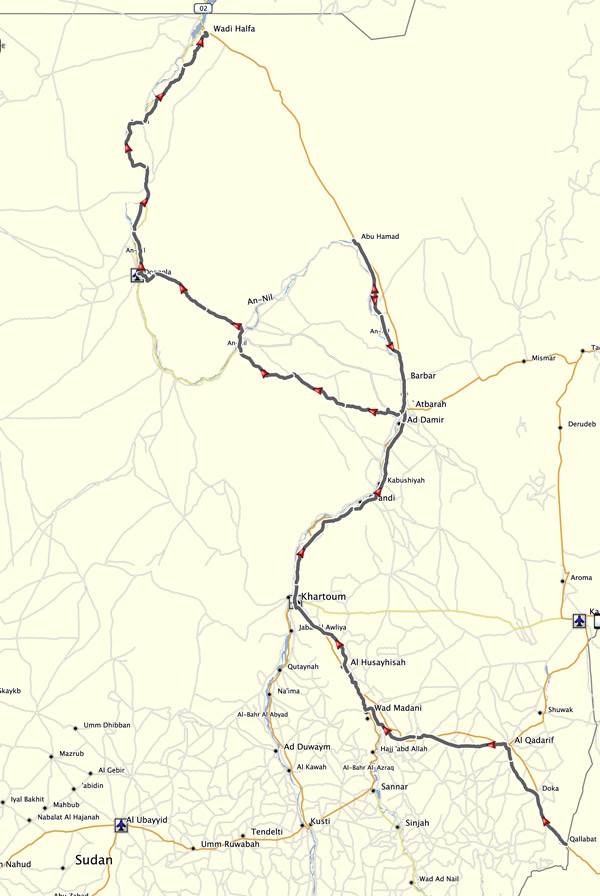
In climatically harsh corners of the world, access for routine measurements and maintenance of a weather station is impractical, so the infrared energy emitted by land can only be detected with NASA satellites. These are their top ten highest ever recorded air temperatures on the planet (in degrees Fahrenheit) and (Celsius):
1. El Azizia, Libya (136) (57,8)
2. Death Valley, California (134) (56,6)
3. Ghadames, Libya (131) (55)
3. Kebili, Tunisia (131) (55)
5. Timbuktu, Mali (130) (54,4)
5. Araouane, Mali (130) (54,4)
7. Tirat Tsvi, Israel (129) (53,9)
8. Ahwaz, Iran (128) (53,3)
8. Agha Jari, Iran (128) (53,3)
10. Wadi Halfa, Sudan (127) (52,7)
Me, Ana and our Yamaha only landed in the place ranked at the bottom of this top ten, so no glory to behold. To our defense, it was July, so at least we had made it to number 10 at the peak of summer. The little town of Halfa, as locals call it, is the only border crossing in use between Sudan and Egypt. In the wake of the 20th century, the egyptians decided to flood it, along with the entire homeland of Nubian people, sinking them both under Lake Nasser, world's second largest manmade lake. Egypt needed a dam to harvest more Nile. We would learn more about the consequences of that dam a little later. Now our main concern was to cross this water border with the weekly ferry to Aswan. It must be told that there is a brand new overland route, but Egypt keeps postponing its grand inauguration for many months. Reportedly some overland jeeps have already driven on it, after paying thousands of dollars for the privilege and the armed escort.
Our journey across Sudan had been more humbling than ever. Maybe the dreaded ferry was just the right end to it. The Sudanese visa was easy to sort out in Nairobi, requiring just a bogus hotel booking and a letter from our embassy. The funny thing is that even if the Sudanese ATMs don't take foreign cards (we did not believe that until trying ourselves), we had to hand in for the visa a xerox of our VISA. For the Yamaha we had to wait a couple of hours at the border, while temperatures soared and a soft rain flickered, so that the custom people could enjoy a meal, a nap and a prayer. Time we had plenty, and we got a great deal for waiting patiently. 15 Sudanese pound for the temporary import permit. Again, details on how to overland without a Carnet, our take, on the HUBB.
The question Africans ask us all the time and that we also often ask ourselves is: 'why do we travel?' I guess some people travel to get that perfect tan by the side of a pool, but we don't know many who do. Travel can be a testing gap in what we take for granted. Learning how to fix your bike with whatever you can find and then pull it through difficult terrain, negotiating roadside purchases in a foreign language, mastering a crackling fire where lion footprints are fresh. New skills for the new you reward the decision to allow yourself to be vulnerable. Since traveling, the world has become more 'real' to us, but the scope of our journey, besides our subsidiary quest for a 'home', has been meeting the people and sharing their lifestyle. If you are like us, and travel for the people, Sudan is a treat. The hospitality of the Sudanese is legendary, and we didn't need to move away from the border to experience it, as the officers invited us to share their food. Our first bushcamp that night was sketchy, but it was dry, the sky was clear and we were happy to sweat again.

First breakfast was a bit goaty for 7 in the morning (flat unleavened bread with goat soup, lentil soup and goat offal stew), but the cook in blue galabiyya was so happy to feed us, that we couldn't say no.

Crossing the bridge over the Blue and White Nile confluence in Khartoum, we felt we should wash down the protein loaded breakfast with something raw. We swung by the market and found this juicing joint.


Now, you need to know these are the best fruit juices in the world. Sudan, once the largest country in Africa, after the independence of South Sudan falling into second, is basically a vast, baking desert. Compared to Egypt, the Nile valley is barely a trickle of life across the ocean of dunes and bare rock. But somehow delicious fruit is widely available, and cheap, so are the amazing freshly squeezed juices and homemade yoghurt smoothies. And they will gladly fix you a custom blend of your choice, should you ask. I got mine just right: half guava, half lime.

Actually, all the food is Sudan is very good. Saffron rice, pickles, kebabs, falafel, roasted meats, soups, salads, lentil pancakes and lots of inexpensive flat bread. You can tell the people love to eat and to share their food with strangers, as we were often invited to grab a bite or taste a dish. At every corner of the dusty capital and dotting the national routes between towns, women brew ethiopian coffee and tea. The Sudanese had already impressed us with their beauty and pizzazz, even if there is very little on display, because in Sudan, a muslim country, is enforced a form of sharia.

But the tea ladies were positively gorgeous, even more so in their vividly colored, transparent veils. Their tea stands are minuscule, but somehow kept neat and perfectly organized. The tea lady would sit upright on her stool for hours, brewing, mixing, serving and cleaning, without losing her smile and grace. Like Sayida, for instance:

So was Fatuma, who seemed to like me 

Sayida has, like all tea ladies, a collection of glass jars with cardamon, cinnamon, pomegranate peel, ginger and other spices and aromatic grasses, that you can perfume your tea with. We noticed that many people, particularly the old, are very picky with their tea. One grandpa even walked to the stand with his own blend tucked in a piece of paper. He would only trust the tea lady with boiling the water. Sayida's palls were hyped we had stopped by the stand.


After a spicy sandwich of stewed eggplants in pita bread, we left, stoping here and there to peel off the melting socks and let our sorry feet breathe. Since entering Sudan we had been recording temperatures of 52-54 Celsius by day, and 27 at dawn. Our routine had changed: drive from 6 to 22, with long breaks around noon.


In this extreme weather people bodies should be rotting along the road, just like dead cattle do on some stretches. This reminded us of Mauritania, only with great food, fabulous people and an amazing lifeline: Free, good drinking water for everyone. Clay amphoras filled with cold water are laid out with a cup for everyone to share, under the shade of brick or concrete kiosks all over the country. Sometimes a chair, a bench, or even a carpet, so that the thirty and the tired can rest and survive. We love the concept, Africa should see more of this. In one of these man made oasis the caretaker heard our Yamaha, and came by to ask if we needed any food. We pushed on to another top notch campsite. After showering in our own sweat for two days, we decided to sacrifice some water to freshen up a bit. We managed to drop-shower and brush our teeth with less than 2 cups.
When we had pitched, it was crazy hot, quiet and beautiful, as only the desert can be. We had missed it. We noticed some distant lightening in the distance, but we took them for harmless wrinkles on the perfectly starlit sky. We were wrong. Not even an hour later, the storm hit. First the wind shook us well and scattered some sand. Then it started to pour, a massive, relentless rain. Lightings stroke. Thunders roared. It was scary. We were alone in the desert, facing the most powerful storm in the whole Africa journey. What was this? Tent quickly filled with water, and we heard the bike falling on one side as the mushy sand gave up under its weight. But we had to stay inside, where it was raining just like in a tropical jungle, or the tent would have been swept away by the wind. I am amazed the poles and the fabric didn't break, because we had to hold the tent walls against the pounding rain for a couple of hours. We had no clue how to deal with all that, what if the torrents would come sweeping? Miraculously, the wind calmed a bit, so I went out to lift the bike. After serving her well on many thousands of miles, Ana's old sneaker was sacrificed to make a sidestand for our Yamaha.

Maybe another hour later rain, wind, lighting and thunder all lost intensity. Now we could hear into the desert silence, and it was worrisome. It sounded like water flowing, and coming out of the tent we saw rainwater streaming across the desert, under the moonlight. We had been more lucky than cautious to pitch camp on a patch of higher ground, so we might be safe, even if surrounded by cascading streams. There were distant trucks honking: we had crossed a dry riverbed earlier, which must have been flooded, with the trucks ambushed by storm. It was difficult to sleep that night. The fact that we had taken a thorough shower while hanging for dear life inside the tent, or that our stuff, except for the gizmo backpack, was soaking wet counted less than the paranoia that the storm was not over. The brisk morning was quiet, almost dry, but last night drama was still evident.


Small pools lingered inside

In half an hour everything was dry again. Packed up our bits, and left to find people, and tea. Now I realize that at this point into the story you might have grown impatient with the abundant text, and the lack of supporting photos. We'll explain why.
After last night's storm, we felt alienated from the security and assertiveness of human settlements, we missed our friends and families. But the beauty of Sudan melted the panic away. We had reached the fringes of the ochre Nubian desert, where rocks glisten blue under scorching sun.

We enjoy scorching sun, so I revved up my bike and hit the dunes. Until I ended up in a DRC moment, only in the copycat the swamp was blistering sand, instead of cotton mud.
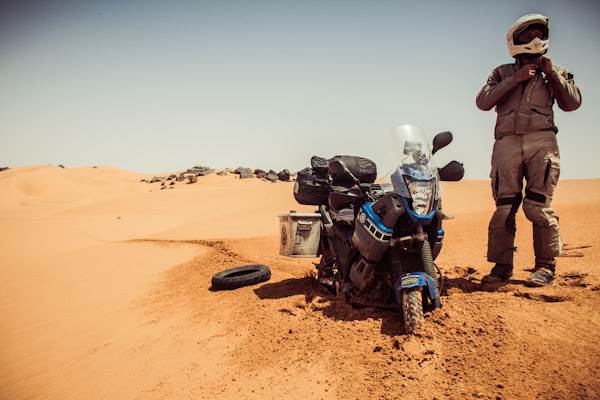
And flashback to DRC

A man arrived on his camel, not too bummed we would not take it for a ride, but rather happy to give a hand.



The light bike felt awesome on dunes, I had a blast. It had possible soared to 54sh Celsius, but I was enjoying my riding, and Ana her shooting. We had almost forgotten to check out the Meroe pyramids behind the dunes. From 592 BC to 350 AC the Meroitic black pharaohs thrived on this land, finally conceding power to the Abyssinians arrived from modern day Ethiopia. Their narrow pyramids cluster in the well preserved Begrawiya site, a geometry even more striking against the soft profile of the desert.

Unfortunately this was our final photo in Sudan. Abruptly, the camera stopped working. I tried in vain to resuscitate it for the next days, it never powered up again. To make our day even 'better', minutes after the Canon heart attack, our Garmin GPS died as well. It was the second GPS to lose on the trip. That night in the bush the mood was as bleak as it gets: we had a basic map of East Africa, but without a GPS we would never find customs offices and whatnot to sort our papers in Egypt. Now we were sure prey for the egyptian fixers. We could see no end to the sacrifices that the journey demanded. We were surrounded by clean desert, but we hardly slept.
The next day we arrived in Abu Hamed, the last stop before the final push to Halfa. 340 km more to reach the border we had feared the most. In our original plans from the 2010, before the crash, we had not included Sudan, nor Egypt, knowing that it would be difficult, if not impossible, to cross the border without a Carnet de Passage. Now Yemen and Syria were in turmoil, so without satellite communication or other emergency device we would not attempt to cross them alone. Egypt was the only logical next step. In Abu Hamed the sidewalk was melting. We had developed by now a routine of pouring water over our riding gear and heads whenever we could find it plentiful. Quite effective in the blistering desert wind. But the mix of stress from last day's events and intense heat made us both feel dizzy. We pulled by a falafel joint to recover with a cup of strong cardamon tea. We were welcomed again with heart melting smiles and incredible hospitality. Hearing that we were about to leave for Halfa, everybody jumped off their chairs: 'the road is very bad, you cannot go, you must go back and follow the new tarred road!' So we were not on the new road then? The GPS had broken before Atbara, I guess we must have missed a turn. The Abu Hamed alternate route to Halfa is pure offroad, and it runs parallel to the train rail, with stations every 30 km. Halfway, at station 5 we would find a rest place with water and tea, but should anything go wrong, for the rest of the journey we'd be alone in the desert. 'There is very little traffic', the men insisted. After a lengthy debate, we had to concede it was irresponsible to continue. We were in no shape or gear to risk being stranded under intense weather.
So we turned back. Now if we were to catch that damn ferry at all we had to do at least 650 km before the end of the day. Back in Atbara we juiced up for the 200 km stretch of nothing that comes next. We kept thinking about that cyclist met we had a few days ago, wondering how did he cope where there are no settlements, and no amphoras. This new road is like they say in Abu Hamed: super smooth Chinese tar, man made perfection in an imperfect landscape of surreal beauty. The empty space gives one time to think about things. It was rough, but we made it to Dongola with our water reserves just about to end. Dongola had great beat, water was no longer as brown as in Atbara, bakeries baked bread, falafel stands smelled good, people smiled. We filled up the tank, then we camped, assured that we had done our job for the day. We had driven approximatively 730 km. Sun set again as if a huge red bulb had been turned off in the distant haze.
We woke up with only 200 km to do. The game plan for the day was to arrive before noon, find a hotel and buy tickets for the ferry. Wadi Halfa is home to the remaining original inhabitants of the Nubian town of Halfa, now lying on the bottom of Lake Nasser. The few families that resisted forced government relocation founded an unassuming settlement that hardly looks like the important border town that it actually is. Every overlander has heard about Mr. Fix-It-All in Halfa. As much as we hate the 'fixer' concept, today, when we are writing this, and are able to put things into perspective, we must admit that Mazar is not a bad guy. We met him on our way to the docks taking home a girl from the UK who had arrived from Aswan. Many travelers stay for free at his place, and he takes care of all their papers and shit. Mazar is considerate, well spoken, and to be honest never asked anything from us. Theoretically we did not need him. The thing is, the ferry has a catch: it leaves on wednesday, but your vehicle travels by a barge, that leaves a day or more after the ferry. So you cannot load your vehicle yourself, unless willing to spend another week in Halfa waiting for the next boat and a hefty fee for storage in Aswan. Here's comes Mazar, whom we had to relinquish the bike key, to load the Yamaha on the barge that was not even there yet. That night we hit town for a few carafes of the famous Halfa lime juice with Kostas, a greek journalist who is paid to ride different bikes around the world. He had arrived from Egypt and was going to Cape Town, then to South America. The hot topic was his experience on the newly inaugurated RO-RO from Turkey to Port Said, currently the only option in or out of Africa. Back to our hotel, we were anticipating a frenzy on the ferry: the place had filled up to capacity, luggage flooded any available space. But we had no idea.
After a final Sudanese breakfast of fuul with gibna (cheese), rocket and olive oil, we fought with 500 more people onboard for a place under deck. We were embarking for the craziest 24 hours journey. On that Ark, in that Babylon, we would endure every imaginable emotion and smell, experience revolt and awe, and meet and befriend Carola and Joe, who would play a significant part in our future.
|

1 Aug 2012
|
|
Registered Users
Veteran HUBBer
|
|
Join Date: Mar 2010
Location: Bucharest, Romania
Posts: 117
|
|
|
Trapped In Travel Purgatory
Egypt, Aswan 11 - 17/07/2012
Day 398 of our journey. We were finally in front of the 'Arrival Hole' (sic!) to Egypt, but more than 2 millennia late. The ancient egyptians had long disappeared, leaving behind a lot for the rest of humanity to wonder at, and for their 7th century invaders to profit from.

After more than 24 hours in the gut of the most horrific mess of a ferry in the entire Africa, we were at our wits end. We crawled out, together with our 500 fellow inmates, dirty, puffy eyes, smelling as if we had spent the night in the sewer. Here's how the ferry crossing had played out:
First the lucky few who had booked first class cabins weeks ago claimed their place on top of the food chain. The rest of our sorry asses would kill each other to squat on every inch available on the upper deck, on hallways and under deck. We gazed at our Yamaha through the window.
Within minutes, toilets started to reek, so breathing become difficult in the seedy underbelly of the ship. But we haven't even left the port yet. We were unaware that this trip was the prologue of our worst experience in the entire Africa.
First, our passports were confiscated by the crew. They would return them to us when we would arrive on the other side. The passports were chucked along 500 others in a cardboard box, so you might think it would have been tricky to fish them out again. But we were only four foreigners on this ship, us two, plus Carola and Joe. Remember that daytime temperatures have been hovering around 50 Celsius. On the ferry that required constant relocation. Moving from under deck to the upper deck, we could witness life unfolding: mothers breastfeeding babies people would accidentally spill soup on (actually at least Ana did), fathers rearing their progenitors with a good beating, men peeing, women gossiping, people fighting for the one meal included in the ticket, then snacking on nuts and seeds they would later sleep on. The smells and sites are difficult to describe. But the worse of all was the constant noise. For the over 24 hours we were on board of this mess, people did not stop talking, or to be accurate, shouting. First we were too excited and hot to sleep, but finally we had to concede we were too exhausted to sit on the benches and keep being the center of attention. Men were on one side of the ship, we were on the other, with women and kids. Arguably, it was noisier in the women compartment. But they were also kind and beautiful, so we could admire their exquisite henna tattoos while sipping on tea.
In the meantime, in the central hallway, on the WC doorstep, two women had laid out a veritable boutique, selling anything from trinkets, scented oils, incense, and food. We went on the upper deck, where 150 men were praying. We were impressed, but we will had no place to sleep on. Nighttime found us in an intense debate with the crew, who kept changing their mind about where we were allowed to squat. Around us people laid on top of each other and our bags, without being bothered. Finally, after a lot of begging, it was agreed that we can lay our mattresses on the deck. It was so windy that we had to wrap scarves around our heads and stuff our ears with TP. It was not quiet, but it was fine. I cannot imagine what the two men who keep chatting all night by our side had to share. Maybe their lifetime story, or an entire movie trilogy.
In the morning Joe tried to unfold back into normality. He has been backpacking since last October from San Francisco across Latin America. In Cape Town he had found a companion in Carola, a Berlin native. As much we we enjoyed the company of the Sudanese, the four of us felt trapped in the same purgatory, united in misery, like inmates in a prison, plotting an escape. Long time travelers, we had a lot of experiences and opinions to share. We were the last onboard to receive our passports. Visas are not a problem for this super touristic country: 15 bucks at any port of entry. The good news about Egypt stop there. Because to bring their vehicle into the holy land of the pharaohs, one must endure all the trauma of humanity since the time of the pyramids. It would take us a couple of days to be convinced that we would never be allowed to take our bike out of there without a Carnet de Passage. As we didn't carry one, for very valid reasons, the Saudi Club would issue one for us. I cannot even think about the costs we had to negotiate without popping a vein. When egyptian mafia will be through with us, we'll be as broke as a newborn baby.
Those who travel with their own Carnet can easily avoid the utterly useless Aswan fixers. They do nothing you cannot do yourself. After a ping-pong of phone calls to Cairo, Hurghada, Aswan and Sudan, we had to concede the fight was over. After telling us about the 72 hours transit Carnet, the club people changed their mind, and refused to issue it. It simply wasn't profitable enough for them. Because, my friend, that's what Egypt is all about. Money.
'I Love your Money"
So fixer for us it was. First he drove us four to town. From the rooftop of our hotel we had a superb view over the Nile and the Elephantine Island.
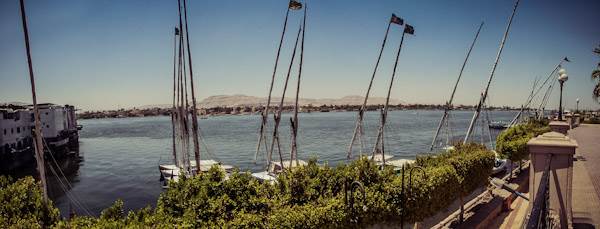
In the room we noticed how modern islam has become

At night the suuk of Aswan started buzzing.
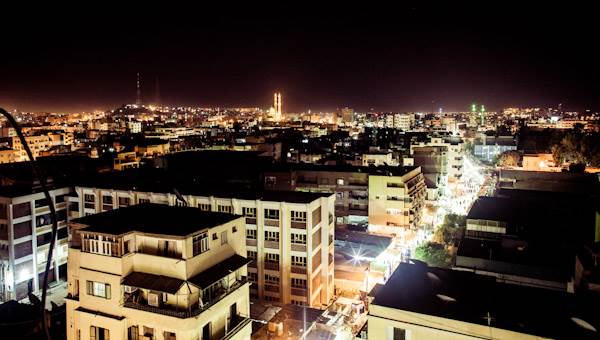
During the next 48 hours we would experience more embarrassing and unpleasant moments than all of us had had in the rest of Africa and, in Joe's situation, the Americas. The only remarkably positive event of those days was that, as you can see, our camera came back to life. After pretending for days that the gizmo dramas was behind us, since arriving in Aswan he had been jerking and trying to turn on and off our ever growing collection of damaged goods. Armed with a working camera, we were ready to record whatever Egypt wanted to throw at us. Like shopping for groceries.


We struggled to perform the simplest tasks like buying bread, or tea. Quoted up to a whopping 10 times the normal price, groped (even if the girls were wearing scarves), hassled and even pushed, for the first time in our journey we had a hard time enjoying it. "I love your money' is what someone literally told Carola, after lots others worked on their own catch phrases like: 'I can help you spend your money', 'You know how much?', 'What do you want', 'No hassle' (performed while firmly grabbing your arm), or just 'Money'. Don't get me wrong, we are the same people who spent months in Nigeria and DRC, both notorius for not being the easiest countries, and we will continue to advocate that they've been both misunderstood. We are talking random, unprovoked act of humanity here. Ancient egyptians must have been quite cool, and the nation that inherited their civilization is not that bad. But there are a lot of 'bastards' out there, as James had warned us months ago, and they do no favors for the legendary muslim hospitality. After the wonderful Sudan, this is even more striking. Let's take the so called 'teagate': every man in Egypt, from poor to rich, from shop owner to garbage boy, can be seen at any time of the day constantly sipping tea, either in the men-only ahwas, or in their workplace. The tea, which for example in Turkey is a free token of hospitality, is good indeed. But Egyptians would not share this tea with us, unless we paid for it the price of aged whisky. Slowly we learnt how to avoid being ripped off, so we could sample some local food. Which is less than great, given all the history and favorable geography. Sure, there are kebabs and pigeons stuffed with pilaf, but they sound better than they taste. Salads were never fresh, tahini was bland. The fuul and ta'amyia (lava falafel) are excellent though, so are Sayid's hand-tossed pizzas, the meat pies and the traditional fast-food, kushere, a mix of carbs (rice, pasta, noodles), with tomato sauce, lentils and chickpeas.


Mind you, while going through all this, our Yamaha had not yet left the Sudanese soil. After exhausting all means of sorting our papers alone, with nothing else better to do, we decided to join Carola and Joe on a trip to Abu Simbel. In 1902 the british built a first dam on the Nile. It proved not good enough, so 6 decades later work started for a second High Dam. The consequences of it are yet to be understood. Sure, it provides water to irrigate innumerable farms and electricity for 15% of egyptian households. But is also impoverishes the soil by depriving it of natural sediments, it disturbs endemic wildlife. Many treasures of the ancient world, along with the entire Nubia, have vanished under Lake Nasser.
The remarkable temple complex of Abu Simbel was saved in a unique international operation. The temple of Ramses II and the smaller secondary temple were cut, then reassembled like a giant puzzle, 100 m back, and 200 m higher, against artificial hills.

After brushing off hundreds of desperate vendors loaded with tourist junk, we arrived dumbfounded and speechless, in front of the four 20 m high colossi that mark the entrace to the main temple.
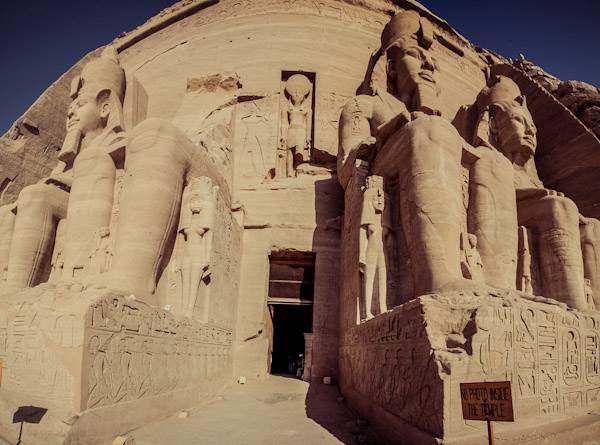

The unique facade speaks of a pharaoh with an ego like no other. By his feet, statues of his mother and favorite wife, Nefertari.

The interior of the temple is exquisitely decorated with bas-reliefs depicting highly formal, ritual scenes of the pharaoh in the company of the gods and the forces of darkness defeated. It is not allowed to take photos, arguably so that the postcards printed in China and on sale at the ubiquitous hasslers can still have a market.

Evidently, moving the temples has forever altered their monumental and esoteric effect. Imagine that they had been carved into a mountain, so that the sun would penetrate inside only on a certain day of the year (hypothetically the pharaoh birthday). Nowadays they sit isolated on top of an artificial landscape. We kept wondering what it must have been like to discover these ancient buildings back in 1813, when the dunes had reached the knees of the colossi. The adventurers who found them must have been quite impressed, as they felt appropriate to mark their names in stone. After the amazing visit to Abu Simbel we were hurdled back into the 7 vehicle convoy, a ridiculous system to move rich foreigners around the country, that his yet to be exploited by the lazy terrorists.
|

1 Aug 2012
|
|
Registered Users
Veteran HUBBer
|
|
Join Date: Mar 2010
Location: Bucharest, Romania
Posts: 117
|
|
|
The Nile Valley And The Red Sea Coast
Egypt 17 - 19/07/2012

As we were informing in a 'fast forward', after long negotiations and after paying for the Aswan and Hurghada mafia' s Ramadan, we finally had our own egyptian no. plates and CpD.

Freeing my bike from the shabby barge brought us to tears.

The port looked like a dump, but we were on cloud nine

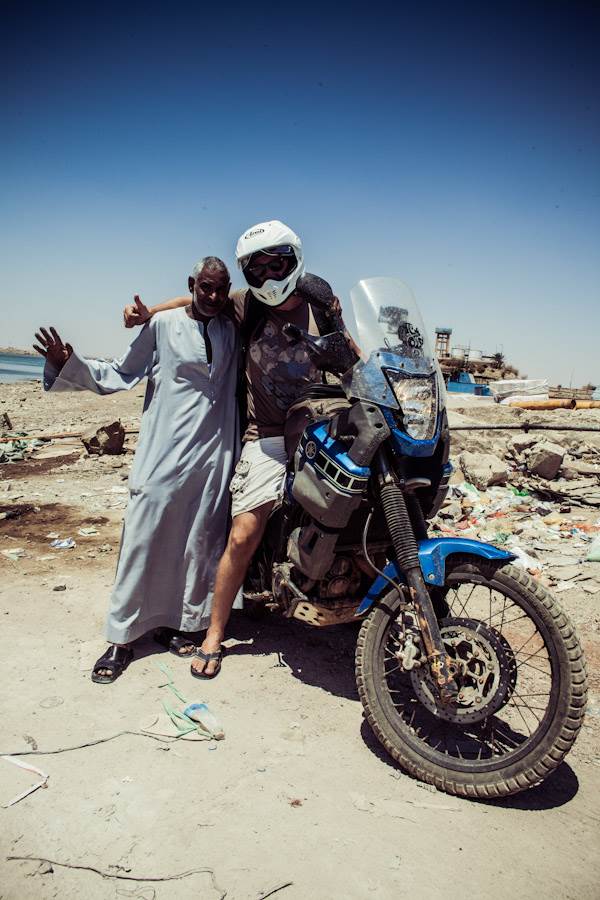
Egypt is said to be a gift of the Nile. To cross it, we took the road along the fecund Nile Valley.
In Luxor, a modern town built on 4000 year old ruin of Thebes, we had time to take in some ancient architecture. Entrance to the highly restricted temple was along a paved processional way, bordered by sphinxes.

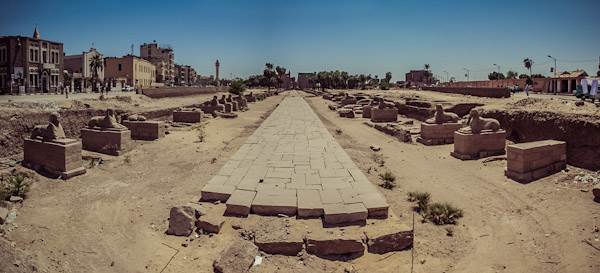
The massive pylon gateway to the Luxor temple is marked by an obelisk. Its pinnacle was once covered in gold, so that it projected the live-giving first rays of sun into the temple.

The temple of Luxor, just like the adjacent complex of Karnak, and like all egyptian temples, was built on sacred sites. The pharaohs were keen to contribute their own design to the existing buildings. The most prominent example is Karnak, the result of over 2000 years of reconstruction.


The processional egyptian rituals dictated a longitudinal temple layout. The hypostyle hall marked the transition from the open courtyard to the progressively smaller and darker succeeding rooms, the last and least accessible one being the sanctuary (naos) where only the god, the pharaoh, or the high priest could enter.

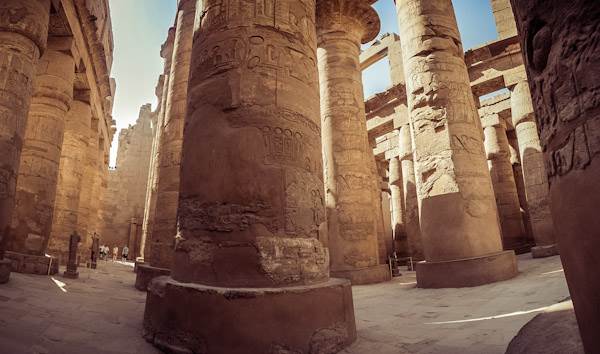

The hypostyle hall of Karnak has been restored to give an idea of its past monumentality, but picture this place decorated in splendid colors.

Whereas in most cultures it's purpose is decorative, Egyptian art, largely unchanged for over 3000 years, was essentially functional. The clear outline, the profile of nose and mouth, the eyes shown as if see from the front were techniques that ensured that the figure could breathe and see and, when magically reactivated through correct rituals, able to function effectively. The hieroglyphic inscriptions usually represent the five names of the pharaoh, followed by protective symbols and epithets such as 'life' or 'health', just like under Islam, the name of the Prophet Mohammed is followed by the formula 'peace be upon him'. Sometimes a cartouche was carved, to protect the royal names, or to prevent potentially negative elements to be magically reactivated.

After so much intellectual effort and a brief meeting with Carola, the ride to Hurghada was a welcome relief. The scenery was breathtaking, but the city was not. The sorry babylon of kitsch contemporary architecture and rubble chucked in such a stunning location is appalling.


Even if we could have afforded the 100 dollars per person (all inclusive) required to stay a night in the massive tourist hub, it was not the right place for us. 100 km north we couldn't resist taking a dip in the uber blue waters of the Red Sea, then, rejuvenated, we rushed to complete our Cape to Cairo race.



|

2 Aug 2012
|
|
Registered Users
Veteran HUBBer
|
|
Join Date: Mar 2010
Location: Bucharest, Romania
Posts: 117
|
|
|
Ramadan In Testosterone City
Cairo 19 - 24/07/2012
'The Tale of the Jewish Physician' from the 'Thousand and One Arabian Nights' (now believed by scholars to have been written by a Cairene in the late medieval period) contains this text: "He who hath not seen Cairo hath not seen the world: her soil is gold, her Nile is a marvel; her women are like the black-eyed hours of Paradise; her houses are palaces; and her air is soft, more odorous than aloes-wood, rejoicing the heart. And how can Cairo be otherwise when she is the Mother of the World?".
These days, as in most mega cities of the world, pollution is rampant, and that endemic haze is not so soft, but there are still palaces and superb mosques scattered throughout. The Nile still feeds the nation across a lush valley. The women, though, are less conspicuous than the old thousand and one stories would suggest, so we cannot vouch they are still as angelic. This is testosterone city, a sprawling mix of museums and pyramids, skyscrapers and medieval gates, of crowded streets with few precious traffic lights and a million bumpers, where car horns never stop, where old cars, bursting buses, donkey carts and pedestrians intermingle in astonishing patterns, and yet keep moving.

Cairo is the largest city in Africa, and in the entire Arab world. Symbolically enough, we had arrived here on the first day of Ramadan, a Friday. It was special to see the immense city in festive mood, with all Cairenes celebrating the holy month. Communal tables are laid out in the street from 7 p.m. till 3 a.m. It is a wonderful opportunity to finally experience some egyptian hospitality.

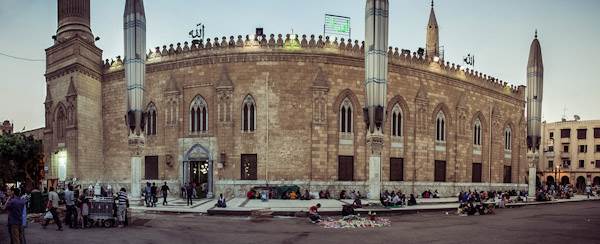
When sun sets, people start flooding the streets and public squares to enjoy the feast and some shopping.



We walked the the grand avenues lined with superb French and stalinist architecture. It is hard not to fall in love with this city. I was also difficult to be at ease there.


Egyptians love to say 'Welcome!' (or 'Welcome to Alaska!), excited by the sight of strangers. But this is a city on speed, and welcome, my brother, sometimes you're not. Sprits are tense, speeds are high and tempers easily lost. As politely as you may refuse the countless offers for stuff you don't want, you are bound to make a few egyptians mad. In the historic Tahrir Square, we tried to imagine how these temperamental people focused their intensity to start the still bubbling Arab Spring. The revolution is weekly reenacted during friday gatherings, and signs of revolt are visible everywhere.


We explored the underbelly of the bazaar of Khan el-Khalili, a market that once gained such a stranglehold over world trade, that Columbus had to seek alternative routes, eventually discovering the new world.
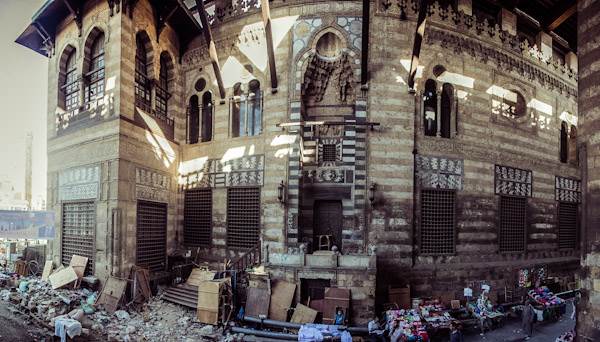

Chinese goods have conquered even this age old market.

Even lentil soup is sold in fast-food packaging branded in the far east

It's astonishing what can be found on the back allies: a diminutive shop with any imaginable trinket for PCs

The oasis of the massive Islamic Cairo are its mosques, like Al Ahzar, world's oldest university, built in AD 970. Students still come here from all Islamic world.



Like they do in the more recent madrases

Cairo being the archetypal melting pot where the many cultures of the world mix with the many ages of the world, its oldest past is not islamic, but christian. The Coptic churches predate the arrival of arabs, but their founders decided to build them on top of the ancient fortress of Babylon.
Then there are those pyramids. When the Ancient Greek civilization was at its peak, they were already 2000 years old. The sprawling Cairo has long swallowed them, along with entire Giza. But to see the pyramids, we had to endure our share of 'torture that no pen can describe from the hungry appeals for baksheesh that gleamed from Arab eyes'. Just like Mark Twain, who wrote these line on his 1866 visit. Once past the aggressive touts and fake 'gifts', we could marvel, knees shaking, at five millennia of human genius.

The pyramid of Kheops, the largest of the last seven wonders of the ancient world still standing
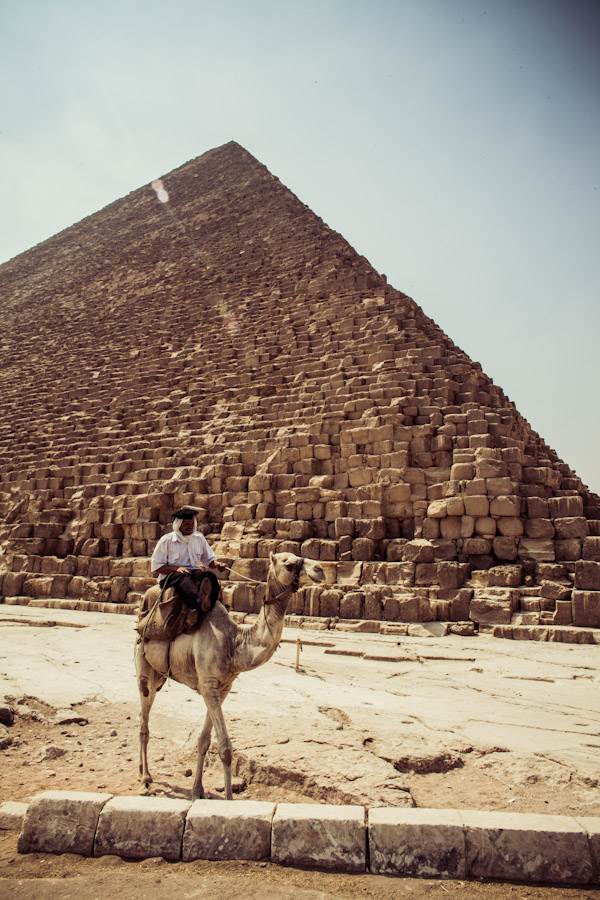
Limestone once covered both the three large and the six small (women) pyramids, making them glisten like crystals in the desert
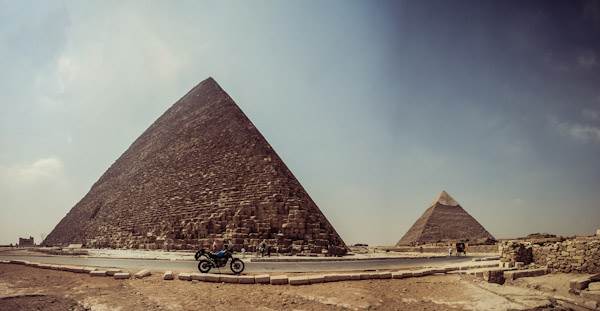
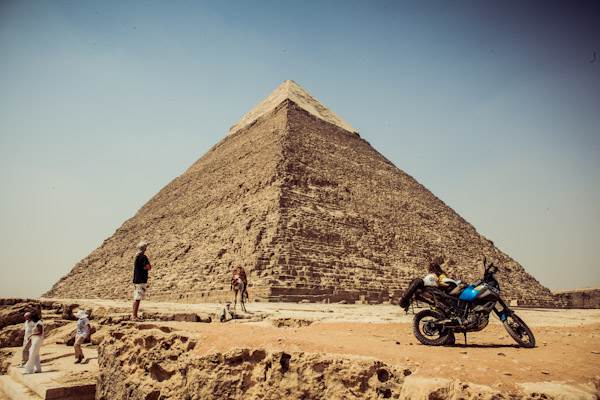
The pyramid of Mycerinus (Menkaure) bares the evidence of a failed 12th century attempt to dismantle it

The Sphinx or Abu al-Hol (the 'father of terror' in arab) was actually carved out of bedrock. It's like meeting your idol in the flesh, impressive, but somehow smaller than we had imagined.

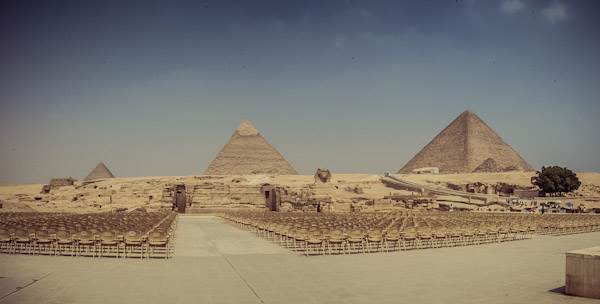
In egyptian veins, Pharaonic blood has been drastically diluted. The most dramatic transformation was not the merit of generations of Libyans, Persians, Greek and Romans, but of the 4000 Arab horsemen who conquered the country in AD 640. Masters of trade, modern egyptians love to do what they do best: sell. But it is difficult to enjoy the site, with vendors of all description tugging persistently at our sleeve, offering camel rides, caleche tours and whatnot. Tourist junk is displayed all over ancient rock and animals are hysterically whipped by men who have forgotten to respect the creature that feeds them.

In the middle of change, the Pyramids are still standing, virtually unchanged and perfect, even if designed and built by imperfect humans.

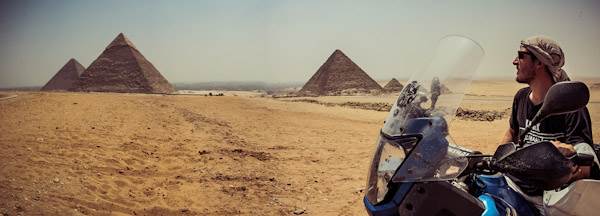
|

9 Aug 2012
|
|
Registered Users
Veteran HUBBer
|
|
Join Date: Mar 2010
Location: Bucharest, Romania
Posts: 117
|
|
|
The Thousand And One Egyptian Sins
Syria becoming a bloodbath has rendered our plans to continue across the Middle East towards Asia obsolete. The only way out of Africa - a continent we are seriously thinking to adopt as home one day - is either west (Libya, Tunisia, then cheap Grimaldi ferry to Sicily) or north-east by ro-ro ship to Turkey. In Nairobi we pondered selling the bike (knowing it could become a financial disaster to overland Egypt), or doing like many do - drive back to South Africa and ship from there to another continent. Confident that we can crack the egyptian mafia, we had to come all the way up to concede that we can't. On the 4th of july the libyan authorities have again suspended all visa services. We spent a day at the embassy in Cairo discussing our chance to obtain this visa before our carnet for Egypt would expire. Turns out there isn't any. The info for the only boat taking travelers and their vehicles across the Mediterranean has been all this time in our weathered Moleskine. This boat leaves on Tuesday evening. So we decide to take it. Follows part two of what we had endured in Aswan.
The curtain rises to a scene of our bare minimum spread on the sidewalk in downtown Cairo. It's Tuesday, not even 6 a.m., and police is frantically searching our panniers for something unruly. We are about to leave for Port Said, where we have an appointment in the office of AK Naggar Shipping. Established only due to the Suez Canal, Port Said doesn't look like the most prosperous egyptian city, as the Human Development Index suggests.
 source
source
It's Ramadan, most offices work only a few hours a day. We set to wait for Nabil, who heads the booking agency handling the infamous boat. He shows up an hour and a half late, but doesn't shy away from scolding us for asking questions (do other people just pay?). Oh, the boat is yet to arrive tonight, then it'll wait in the port until tomorrow to be unloaded.
We are asked to pay:
$200 per motorbike ($500/car)
$300 per passenger
$125 booking fee + 'shipping order' for Canal Shipping where the customs clearance is done
$205 customs clearance (1250 EGP)
That makes $1130 for us and the bike. Mind you, the cost for 1 bike + 1 person coming from Turkey (on the very same boat), all included, is $278, as opposed to $830. Prices for the boat are up 50% since April, customs clearance has almost doubled. Nabil has the audacity to say that we are 'unlucky' for showing up during Ramadan, when everything is more expensive. For a while he tries to intimidate us into paying 1500 EGP for customs clearance. We ask why, when he initially said 1250, already more than the 750 EGP recently paid by others? We are told to pay our tickets and go clear customs in the office of Canal Shipping, which is a block away. You might think that for over a grand we would be politely invited to wait on a couch. Well, because we ask questions, we shall suffer.
In Sayed Saleh's office, Nabil is on the speed dial. Here a working day is even more fun: chatting with friends, checking sports news online, and mostly playing with a coin in your empty ashtray while staring spaced-out at the streetscape. After working for years to come to Africa, this doesn't leave us unimpressed. Assam has a short temper and poor english, Mohammed doesn't speak any. These employees of Sayed are supposed to do the actual customs clearing work. We ask how much we need to pay. Everybody is appalled. We are sent with the two stooges to 'ask in the port'. A useless trip: in the port we aren't even allowed to wait by the gate as random bums walk freely in and out. The two stooges go someplace to 'ask for us'. Of course they return with the news that we should pay 1300 EGP. We reply that we are prepared to pay not more than what we did in Aswan for the same bogus customs clearance, so 505 EGP. The same 'merchandise', the same country, right? Assam, the rudest and most aggressive of the lot, starts shouting that they made a mistake in Aswan and this is the CORRECT amount, and walks away. Back in Canal Shipping office, back to square one. Hours pass, we realize we cannot break the chain of middle men. Finally we figure that customs clearance is still 750 EGP (whatever that means and whoever gets bribed), 50 is for storing the vehicle in the port (why should we do that when the boat is not even accessible until tomorrow?), the rest is 'commission'. We look at each other. We admit we don't have the balls to attempt Syria. And we don't' have enough money to make a point and ship ourselves out of here. For us it's too late, we cannot go back. So we agree to bloody pay. We take another useless trip to traffic police, where supposedly the officers must 'see' me to issue a certificate that I haven't been involved in no accidents. Of course, I am told to wait outside while the two stupid dogs go xerox my egyptian and romanian driving licenses. Nobody comes to see, bothers to inspect the bike, or ask for a document containing any actual data about the vehicle being 'cleared'. Check out what is written on the egyptian carnet, which goes in my file, along the above mentioned photocopies and a form.

This mess plays out as if Assam and Mohammed are doing it for the first time. A few hours into the process, Mohammed asks candidly if we have a car or a motorbike and where is our boat supposed to go. Back at the booking agency, we empty our wallet into Nabil's hands that start to shake with gluttony. His voice changes, his eyes glisten, his back arches under the weight of a thousand and one egyptian sins written in his DNA. It's over, and this is the only evidence we will ever have:
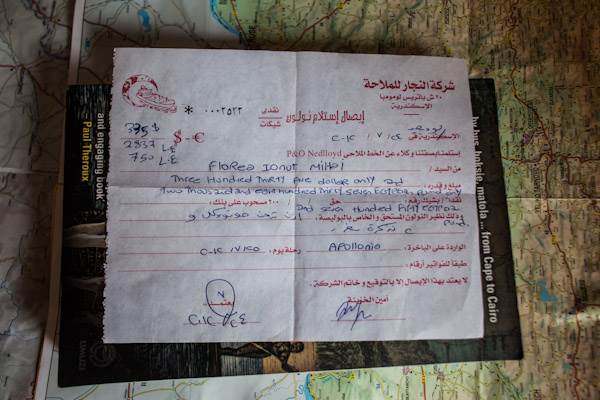
Port Said is a city of booking agents, shipping companies and custom people. Why have we all come to the same booking agent, blatantly in cohorts with the customs? These shady characters will party hard with our money. We don't have energy left to enjoy our last after in Africa. We buy tomatoes, cheese, bread and figs. The market is great, the people seem nice, and in the night everybody will feast on shrimp and squid. But we are spent. We curl into our Hotel de la Poste lair, and sleep.
The next morning we drive to Sayed, where we wait for a couple of hours until Assam remembers we must take the bike to the port and start collecting stamps in my file. More mambo jumbo ends in me having to leave the bike in storage for a few hours. The boat has been loaded and awaits us, departure is scheduled for 6 p.m. At 4 p.m. we are still in Nabil's, numb of waiting, each with our own departure though to digest. Ana walks to the market to spend our last pounds on more tomatoes, cheese and bread. And figs. And dried dates. We save a bill of 50, what if they will ask for a storage fee for the bike? we say. A turkish driver shares our waiting couch and people are discussing furiously something. The driver turns to us: 'problem', he says. 'What problem?' I ask. It turns out he doesn't have a CpD. We tell him how we got one from the Saudi club in Aswan. Nabil and his employees seem bewildered by this information. We give them the contacts of the club and the fixers, they discuss, but we don't know the outcome, because suddenly a guy from the office informs us we must literally run to immigration to get our passports stamped. There everybody is busy distributing Ramadan packages. We get the stamps, then we run some more to the guy's car who drives us back to where our bike is stored. They ask 150 EGP for storage. I laugh and I tell them I have only 50 left. I mount back the luggage and I drive it to the boat where a couple of hours later, after Sayed, Assam and Mohammed had fought a few fights, a man arrives to inspect our bike and the file. They want to make sure we are taking our dubious vehicle out of their bureaucratic life, and we cannot wait to do so. In the end, crossing Egypt with this vehicle costed an astonishing 1750 US dollars, 3 times more than 22 other African countries combined, including the ferry from Europe to Morocco! Egypt overland, never again.

On the boat bearing the logo of Scanlines under Moldavian pavilion, it's just us, three turkish drivers with their trucks, the russian and ukrainian crew and a turkish chef. After 9 p.m. we budge. The dinner is typically turkish, but not bad.

The cabin is spotless, but scalding hot.


We struggle all night to catch some sleep, and in the morning we discover that the boat is back in the port, in the same place we were the night before. Lunch passes, hours pass, and we hear there is a passenger we are waiting for. Late afternoon trucks start arriving: the boat fills up with russian and turkish truck drivers and their vehicles bearing the 'transit' plate we fought in vain for.

It's Thursday and sun is setting over Africa as the boat finally exits the Suez Channel. For us, Africa ended two countries ago, but we are still heartbroken. We'll come back!

The next days were a blur of sweating, showering and waiting for the next meal to happen, while Ana discovered that she could still speak rudimentary Turkish.
 Carola's account
Carola's account of her own trip is spot on. Unfortunately it also says that there is no other agent for this boat. What can you do to avoid this scam? If you have more time, wait for Libya to resume visa services, drive the coastal route (check Temehu.com for news updates), ferry from Tunis to Italy (roughly 150 euro for 2 people + 1 motorbike). Or cross Syria. Or, if you have more money, ship from Port Sudan or Alexandria and fly out. Your choice. We are sorry for the wonderful village people we met in Egypt, but their country is not the best ending to a tour of their great continent.
|

10 Aug 2012
|
|
Registered Users
Veteran HUBBer
|
|
Join Date: Mar 2010
Location: Bucharest, Romania
Posts: 117
|
|
|
Cape To Cairo. Done.
We need to admit this upfront: It's been a fast one. It's been hard to wrap our heads around it with countries changing sometimes on a weekly basis. The East route is arguably considered The Easy One. Partly because you can basically drive a fully automatic city car all the way. It's tarred, except for the Moyale-Marsabit stretch, hailed as the shock-killer of Africa. Frankly, the dreaded stretch was a bore. The Turkana route sounds far more adventurous and rewarding. We eluded a few times the asphalt curse, to pamper our Yamaha in some dirt and our souls in open horizons. The East Route is also The Expensive Route. No more pricey visas, but less rice'n beans mamas, more 'budget' campsites, more temptations (safaris etc). Few of us out there manage to do the road and trek $500/hour gorillas while at it. Sometimes it’s like spying from the street through the windows of a posh mansion where $25 per bottle bergamot-scented sea salt is a staple. A bit frustrating. Until you meet the people. East Africans are more mellow. Smiles flow, bush camping is a treat and hospitality paramount. Besides a sense of accomplishment, we note our regret that we didn't linger. The highlights of this segment of ITW have been:
The uber hospitable motorcycling community of South Africa & the Jones family from the vibrant Johannesburg

Exploring Lesotho and Ethiopian highlands

Flying over the Okavango Delta in flood. Made us want to go back to school and fulfill childhood fantasies of becoming naturalists.

Coming 'home' @ Zambia's Rapid 14
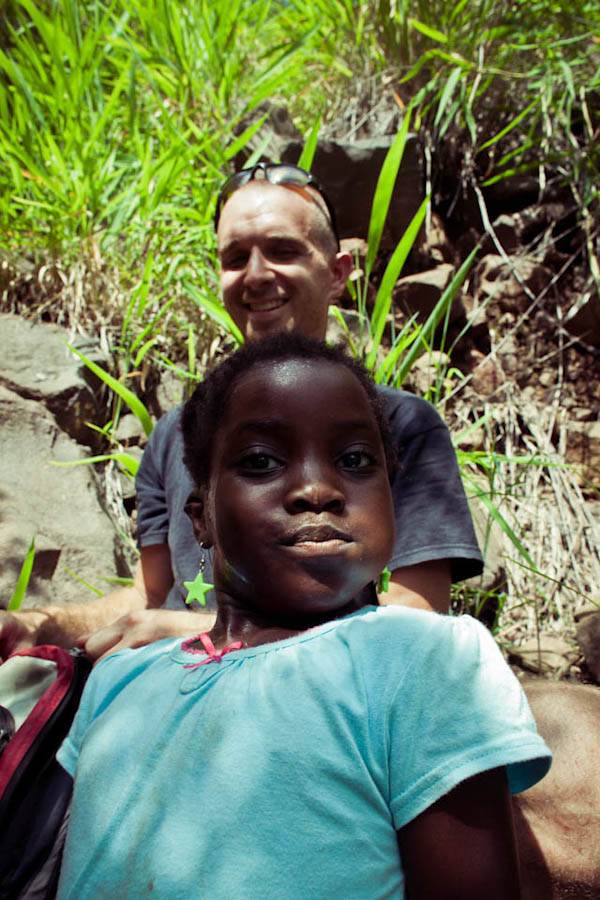
Destination we’d most like to return to: Mozambique. The friendliest people, a chilled afro-latino vibe and lots of wilderness to get lost into across the little visited northern provinces.

Zanzibar. Truly a thing of beauty. In spite of all human mischiefs, the archipelago retains its allure. Natural beauty, amazing people, edge-of-the-world tranquility and (in our book) the best foodie destination across the continent.

Sudan, tamam! Desert and desert people simply speak to our hearts.

The most surprising city: Cairo. Because of its diversity and superb architecture, reminiscent of Paris.

Best food: Zanzibari octopus; best drink: guava & lime in Sudan; best pudding: Zanzibari jackfruit.
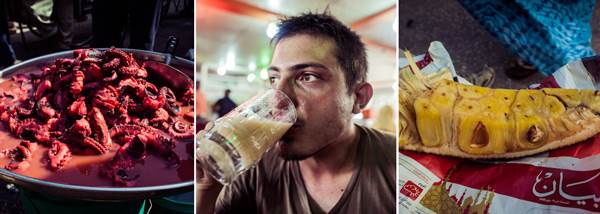
__________________________________________________ __________
To conclude, here are the statistics for this leg:
Journey
• Countries visited: 9 (South Africa, Lesotho, Botswana, Zambia, Mozambique, Tanzania, Kenya, Ethiopia, Sudan, Egypt)
• Number of days spent on the road: 136 (12.03.2012 - 25.07.2012)
• Nights in the tent: 57 (minus 1 on ferry, 78 in real beds - of which 59 couchsurfing in South Africa)
• Distance covered by bike: 21,200 km
• Distance covered together with other overlanders: 0 km (encountered plenty of them in Nairobi)
• Fuel burned: 1060 l
Records
• Highest daytime temperature: +54C (129.2F) (Nubian desert, Sudan)
• Lowest daytime temperature : +7C (Ethiopian Highlands)
• Record continuous riding (km): 730 (Abu Hamad - Dongola, Sudan)
• Record continuous riding (hours): 14 (Addis Ababa - Lalibela, Ethiopia)
• Highest altitude reached by bike: 3,251m / 10,666ft (Tlaeeng Pass, Lesotho)
Maintanance
• Engine oil used: 9 l
• Engine oil filters used: 3
• Air filters cleaned: 5 times
• Front tires used: 1 (Heidenau K60 Scout, bought in Windhoek, totaling an astonishing 25,000 km)
• Rear tires used: 2 (1 Heidenau K60 Scout from Windhoek to Durban, proved faulty, replaced; 1 Michelin Anakee 2 from Durban to Awasa, Ethiopia, where I switched to a second hand K60, a give-away from JJ's Chris)
• Punctured tires: 2 (both in Nairobi)
• Front brake pad sets used: 2 (new sets from JoBurg with the new discs, thanks to Linex Yamaha)
• Rear brake pad sets used: 2
• Rear brake disks used: 0
• Sprocket sets used: 2
• Chains used: 2 (1 from Cape to Cairo, where we bought a new one from the Yamaha dealer)
• Biking gear washed (times): 5
• Bike washed (times): 2
• Tent washed (times): 1
• Mattresses washed (times): 1
• Haircuts: 3
Problems
• Offroad crashes: 7
• Onroad crashes: 0
• Crashes with other vehicles: 0
• Stops by the police: 1 (excluding as usual military posts). In Cairo it was the first time our panniers got searched, medicine packaging broken and mechanical bits spread in the street, making sure that the suspiciously shabby looking motorbike terrorists would not harm the egyptian people.
• Fines for speeding: 0
• Breakdowns: 0
• Minor technical issues: 2 (gear lever replaced with moped bit - Mozambique; exhaust pipe cracked - Egypt)
• Damaged gear: 9 (broken prime lens - Tanzania; broken laptop - Tanzania; broken GPS - Sudan; tankbag torn - R.S.A.; duffel bag proven faulty - Tanzania; several clothing items disintegrated)
• Health issues: 2 (food poisoning - Ana @ Ethiopia; scorpion & Tse Tse sting - Ana @ Mozambique)
• Stolen items: 0
• Lost items: 2 (glove - Lesotho; sunglasses - Egypt)
Money & Visa
• Most expensive fuel: 52 Meticais/l (1,5 Euro/l) - Mozambique
• Cheapest fuel: 1,8 Egyptian pound/liter (0,24 Euro/l) - Egypt
• Local SIM cards bought: 2 (RSA, Egypt)
• Countries with Vodafone roaming available: 8 (South Africa, Botswana, Zambia, Tanzania, Kenya, Ethiopia, Sudan, Egypt)
• Countries not requiring visa for Romanian citizens: 3 (Botswana, Zambia, Tanzania)
In any case, we’re well into planning our next move as I write this. I bought new earphones for my shuffle with 1 euro ( 5 egyptian pounds) and I'm listening to Staff Benda Bilili. The songs are both sad and joyful — the Congolese always seem to find the irony, and even the humor in often hopeless situations, and make music about them. As Coco's unmistakable voice sings about his sister, I smile and I nod, now I am able to understand a little of what he's talking about. I remember how raw our life in the open bush of central Africa has been. Roger's impossibly delicate string attached to a milk tin interrupts my recollection. My limbs struggle to resist the beat. As my eyes wet, I somehow feel our hearts remained with this other Africa, the corrupt, the messy, the difficult to understand and to cross. The easy to love.
|
|
Currently Active Users Viewing This Thread: 1 (0 Registered Users and/or Members and 1 guests)
|
|
|
 Posting Rules
Posting Rules
|
You may not post new threads
You may not post replies
You may not post attachments
You may not edit your posts
HTML code is Off
|
|
|
|

Check the RAW segments; Grant, your HU host is on every month!
Episodes below to listen to while you, err, pretend to do something or other...

2020 Edition of Chris Scott's Adventure Motorcycling Handbook.
"Ultimate global guide for red-blooded bikers planning overseas exploration. Covers choice & preparation of best bike, shipping overseas, baggage design, riding techniques, travel health, visas, documentation, safety and useful addresses." Recommended. (Grant)

Led by special operations veterans, Stanford Medicine affiliated physicians, paramedics and other travel experts, Ripcord is perfect for adventure seekers, climbers, skiers, sports enthusiasts, hunters, international travelers, humanitarian efforts, expeditions and more.
Ripcord Rescue Travel Insurance™ combines into a single integrated program the best evacuation and rescue with the premier travel insurance coverages designed for adventurers and travel is covered on motorcycles of all sizes.
(ONLY US RESIDENTS and currently has a limit of 60 days.)
Ripcord Evacuation Insurance is available for ALL nationalities.
What others say about HU...
"This site is the BIBLE for international bike travelers." Greg, Australia
"Thank you! The web site, The travels, The insight, The inspiration, Everything, just thanks." Colin, UK
"My friend and I are planning a trip from Singapore to England... We found (the HU) site invaluable as an aid to planning and have based a lot of our purchases (bikes, riding gear, etc.) on what we have learned from this site." Phil, Australia
"I for one always had an adventurous spirit, but you and Susan lit the fire for my trip and I'll be forever grateful for what you two do to inspire others to just do it." Brent, USA
"Your website is a mecca of valuable information and the (video) series is informative, entertaining, and inspiring!" Jennifer, Canada
"Your worldwide organisation and events are the Go To places to for all serious touring and aspiring touring bikers." Trevor, South Africa
"This is the answer to all my questions." Haydn, Australia
"Keep going the excellent work you are doing for Horizons Unlimited - I love it!" Thomas, Germany
Lots more comments here!

Every book a diary
Every chapter a day
Every day a journey
Refreshingly honest and compelling tales: the hights and lows of a life on the road. Solo, unsupported, budget journeys of discovery.
Authentic, engaging and evocative travel memoirs, overland, around the world and through life.
All 8 books available from the author or as eBooks and audio books
Back Road Map Books and Backroad GPS Maps for all of Canada - a must have!
New to Horizons Unlimited?
New to motorcycle travelling? New to the HU site? Confused? Too many options? It's really very simple - just 4 easy steps!
Horizons Unlimited was founded in 1997 by Grant and Susan Johnson following their journey around the world on a BMW R80G/S.
 Read more about Grant & Susan's story
Read more about Grant & Susan's story
Membership - help keep us going!
Horizons Unlimited is not a big multi-national company, just two people who love motorcycle travel and have grown what started as a hobby in 1997 into a full time job (usually 8-10 hours per day and 7 days a week) and a labour of love. To keep it going and a roof over our heads, we run events all over the world with the help of volunteers; we sell inspirational and informative DVDs; we have a few selected advertisers; and we make a small amount from memberships.
You don't have to be a Member to come to an HU meeting, access the website, or ask questions on the HUBB. What you get for your membership contribution is our sincere gratitude, good karma and knowing that you're helping to keep the motorcycle travel dream alive. Contributing Members and Gold Members do get additional features on the HUBB. Here's a list of all the Member benefits on the HUBB.
|
|
|















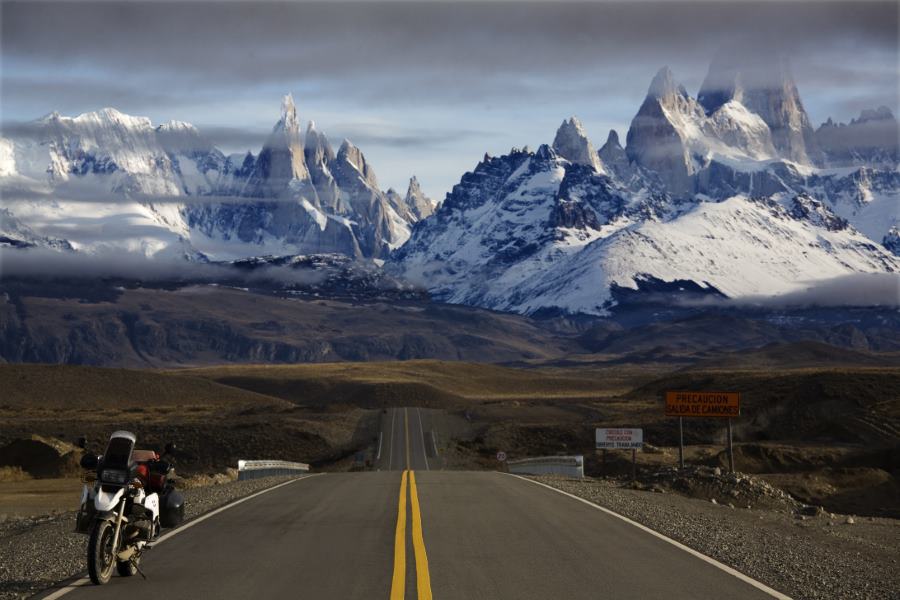

 16Likes
16Likes
















































































































































































































































































































 Linear Mode
Linear Mode










